The Victorian Government
Placeholder artlce of Victorian Government
Placeholder artlce of Victorian Government
 Paul Edbrook, State Labor MP for Frankston, has repeatedly failed to respond usefully to complaints from constituents regarding the forced accommodation of a Metropolitan Activity Centre under the increasingly authoritarian regime of Premier Jacinta Allan's Victorian Government. Inside this article, we have published two complaint letters, along with the negligent and empty responses from Mr. Edbrook or his staff, despite the great importance of the matter.
Paul Edbrook, State Labor MP for Frankston, has repeatedly failed to respond usefully to complaints from constituents regarding the forced accommodation of a Metropolitan Activity Centre under the increasingly authoritarian regime of Premier Jacinta Allan's Victorian Government. Inside this article, we have published two complaint letters, along with the negligent and empty responses from Mr. Edbrook or his staff, despite the great importance of the matter.
 Victorian Parliament is about to come out with shocking announcements that will remove many Victorians' property rights so that planners can redesign Melbourne to be a massive high-rise city like Shanghai or Mumbai. The announcement will probably be made in March. Environmentalists, ecologists, and people concerned about human rights and property rights need to be ready to respond. However, Australians and Victorians do not actually have any strong protection for p
Victorian Parliament is about to come out with shocking announcements that will remove many Victorians' property rights so that planners can redesign Melbourne to be a massive high-rise city like Shanghai or Mumbai. The announcement will probably be made in March. Environmentalists, ecologists, and people concerned about human rights and property rights need to be ready to respond. However, Australians and Victorians do not actually have any strong protection for p
 For the past few days, ABC Melbourne has been creating a talkback fest to make-believe the electorate is looking happily forward to having this city blown up and out beyond recognition and beyond their control. I've received a plethora of emails and phone calls indicating the exact opposite.
For the past few days, ABC Melbourne has been creating a talkback fest to make-believe the electorate is looking happily forward to having this city blown up and out beyond recognition and beyond their control. I've received a plethora of emails and phone calls indicating the exact opposite.
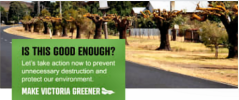 Make Victoria Greener: Prominent botanist and academic, Dr Greg Moore OAM has called for the Minister for Energy and Resources, Lily D’Ambrosio, to vote for common sense and ensure Victoria’s environment is secured for the future by adding $1 billion in tree canopy.
Make Victoria Greener: Prominent botanist and academic, Dr Greg Moore OAM has called for the Minister for Energy and Resources, Lily D’Ambrosio, to vote for common sense and ensure Victoria’s environment is secured for the future by adding $1 billion in tree canopy.
![]() You know those big infrastructure projects, and activity centres, that the Victorian government is ramming down our throats, telling us it will bring 'jobs' and 'affordable' housing? Well, Australian industry is being sidelined on these projects. Weld Australia—which represents thousands of local welders and fabricators—is calling for immediate action against the Victorian Government’s offshoring of steel for major infrastructure projects.
You know those big infrastructure projects, and activity centres, that the Victorian government is ramming down our throats, telling us it will bring 'jobs' and 'affordable' housing? Well, Australian industry is being sidelined on these projects. Weld Australia—which represents thousands of local welders and fabricators—is calling for immediate action against the Victorian Government’s offshoring of steel for major infrastructure projects.
 Basically signals Victorian State Gov attempts to remove Local Governments by stealth: Taking over Council powers without consulting the electorate. Planning is the tool. Council writing to all other Vic Councils encouraging them to stand up to State Gov similarly.
Basically signals Victorian State Gov attempts to remove Local Governments by stealth: Taking over Council powers without consulting the electorate. Planning is the tool. Council writing to all other Vic Councils encouraging them to stand up to State Gov similarly.
 Government regulators have been notified but refused to act. Victorian National Parks Association states that conservation groups are furious after an endangered Greater Glider was found dead in a large habitat tree felled by Forest Fire Management Victoria in the Yarra Ranges National Park.
Government regulators have been notified but refused to act. Victorian National Parks Association states that conservation groups are furious after an endangered Greater Glider was found dead in a large habitat tree felled by Forest Fire Management Victoria in the Yarra Ranges National Park.
 VicRoads recently closed down Hoddle Street for a week to work on streamlining the corridor. The project is expected to continue for the rest of 2018.
VicRoads recently closed down Hoddle Street for a week to work on streamlining the corridor. The project is expected to continue for the rest of 2018.
"Streamlining" in this case is a euphemism for increasing the capacity of Hoddle Street for higher volumes of vehicle traffic every day. Whilst dedicated bus lanes are part of the project the Andrews government intends that the overwhelming future growth in traffic movements will be passenger cars.

The project was previously under serious consideration by the Brumby Labor government which lost office in 2010. It was sidelined by the incoming Baillieu government which, at least initially, sensibly "parked" the project with a view to, at last, building a rail line to Doncaster Hill instead. That did not materialise in the wake of an inadequate analysis that contemplated a rail line from Melbourne CBD, not to the major passenger destination of Doncaster Hill, but to the "Park and Ride" at the intersection of the Eastern Freeway and Doncaster Road in Doncaster.
The fact is that increasing road capacity at the expense of public transport, as the Hoddle Street streamlining project does, is far less space efficient than increased public transport capacity. One fully loaded train carries about as many people as one freeway lane occupied by passenger vehicles in a whole hour. The successor Napthine government's favourite, if critically flawed infrastructure project, the proposed East West Link, would have sacrificed significant open space, including much of the priceless parkland of Royal Park for a "spaghetti junction" with the Tullamarine Freeway in Parkville.
Importantly, it would have also absorbed the median strip on the Eastern Freeway between Hoddle Street and Bulleen Road for additional vehicle lanes. As this space has for years been earmarked for a rail line to Doncaster it would have dealt a severe, if not terminal, blow to the promise of an acceptable public transport service for residents of Melbourne's north eastern suburbs who have no tram or train services.
As we head into this 2018 election year we have a deep obligation to put a stop to this freeway madness and the serial sidelining of public transport by the major parties. There is no sign yet, though, that they have heard the message. If the status quo were to be maintained we also face the future threat of further "streamlining" of Punt Road to the south of the current Hoddle Street project. Existing residential properties in South Yarra would be the victims of that exercise, if it were to see the light of day.
In addition to resurrecting the discredited East West Link project, the coalition also wishes to build the so-called North East Link from Greensborough to the Eastern Freeway. The Labor government, if re-elected, would also build the North East Link as well as the West Gate Tunnel, a cosy deal which it hatched with toll road operator Transurban but did not declare in their election campaigning in 2014. The West Gate Tunnel is proposed instead of the adequate public transport desperately needed by western suburbs residents who the Andrews government claims to serve.
As part of the North East Link project the Victorian government proposes to add seven extra lanes to the Eastern Freeway between Bulleen Road and Springvale Road. The North East Link Authority, the government body established by the Andrews government to "spin" the project to the public has so far been mum on how this is to work. However, one thing is certain: Substantial public parkland would be lost, including much of the Koonung Creek Reserve. This Reserve, even in its current condition is a remnant of the extensive open space in the valley that was lost to the Eastern Freeway when it was opened in 1977 and then progressively extended eastward. Now they want more of it. The Reserve would be reduced to a "buffer zone" between the bloated Eastern Freeway and ever closer residential areas along the Eastern Freeway from Bulleen to Nunawading.
For its part, the West Gate Tunnel would feed more motor car traffic from the western suburbs into the inner suburbs and the Melbourne CBD in much the same way as the government's Hoddle Street "streamlining" project and the East West Link, if it were to materialise, will feed more traffic into inner suburbs and the CBD from the north and the east.
All in all the Victorian government seems set on filling up Melbourne CBD with cars every day in the same manner as the trainless Melbourne Airport.
 The protection of owls might soon go to the Supreme Court and a proposed regulatory change will allow native forest wood to be burnt for electricity. It was been tabled in the House of Reps today, 27 May 2015. There is a danger that Bill Shorten's Labor Party might support the bill, despite what that says about our renewable energy scheme. Read on to find out how we might fight this.
The protection of owls might soon go to the Supreme Court and a proposed regulatory change will allow native forest wood to be burnt for electricity. It was been tabled in the House of Reps today, 27 May 2015. There is a danger that Bill Shorten's Labor Party might support the bill, despite what that says about our renewable energy scheme. Read on to find out how we might fight this.
The court-ordered mediation with the department and VicForests last week did not resolve.
The next step is a Directions hearing on the 26th of June to have the matter heard in the Supreme Court.
We can’t give you much more detail than that at this stage. In the meantime, tell Minister Neville and her Department to protect our rare Owls and their forest in East Gippsland. And if you’d like to help us along with this 4th legal challenge (so far we’ve won or settled 3/3) click here to make a tax-deductible donation.”
Read the background to this case here

The regulatory change that will allow native forest wood to be burnt for electricity has been tabled in the House of Reps today.
It looks like Bill Shorten’s Labor Party might support the bill, even though it means undermining our renewable energy scheme. This is urgent. Please make a quick phone call to Bill Shorten's office and urge that Labor opposes this. (02) 6277 4022.
If Labor opposes this, the vote will be decided by the independents on the crossbench in the Senate. The Senate sits again on June 15, so contact the cross benchers and let them know that you want them to vote against the change to the regulation.
A few suggested points to raise are available here
Some of the crossbenchers have been concerned that the industry will need certainty, and Labor could reverse the regulatory change next in government, so that uncertainty is a point to raise as well. Plus, many still believe the lie that the ‘waste’ will only be the heads and sweepings (!) There needs to be a very clear definition provided before anyone votes on this.
From our experience, emails are good but can get ‘lost’, so phone calls or tweets are better.
|
Ricky Muir (03) 5144 3639 [email protected] Glenn Lazarus (07) 3001 8940 [email protected] Nick Xenophon 08 8232 1144 [email protected] John Madigan (03) 5331 2321 [email protected] Dio Wang (08) 9221 2233 [email protected] David Leyonhjelm (02) 9719 1078 [email protected] |
|
 Last week GECO - Goongerah Environment Centre reported an illegal rainforest logging operation that has occurred on the Errinundra Plateau, East Gippsland. We documented the destruction and sent a report to the Victorian government. The mainstream media reported it, Australians called, emailed, tweeted and talked about it. They asked the Environment Minister to end this senseless destruction and immediately stop logging. The pressure was felt in her office but logging continues and the forests need you to act again.
Last week GECO - Goongerah Environment Centre reported an illegal rainforest logging operation that has occurred on the Errinundra Plateau, East Gippsland. We documented the destruction and sent a report to the Victorian government. The mainstream media reported it, Australians called, emailed, tweeted and talked about it. They asked the Environment Minister to end this senseless destruction and immediately stop logging. The pressure was felt in her office but logging continues and the forests need you to act again.
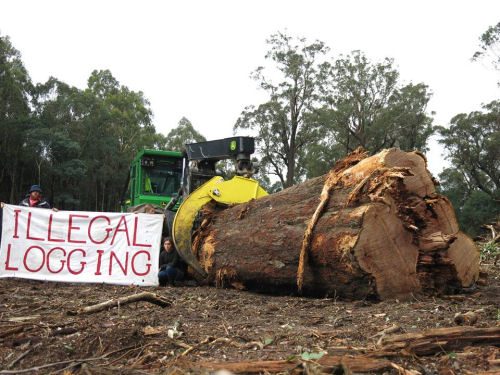 Email: lisa.neville [ AT ] parliament.vic.gov.au
Email: lisa.neville [ AT ] parliament.vic.gov.au
Call: 03 9637 9654
Tweet: @LisanevilleMP
#LogOutOfRainforest #ProsecuteVicForests
GECO - Goongerah Environment Centre reports:
Logging machinery was taken out of the area for a short time and some restrictions have been placed on where logging can now occur. But yesterday we observed that logging has recommenced and ancient trees, some up to 600 years old, near the area where rainforest has been logged are falling today!
We need to act now and let the Victorian Government know that if this matter is being taken seriously all logging operations in the area must immediately stop!
You can remind the Minister's office of the following points.

- Rainforest is a listed as a threatened community under the Flora and Fauna Guarantee Act (FFGA).
- The Sustainable Forests (Timber) Act requires VicForests to comply with the Code of Practice for Timber Production which forbids the logging of rainforest.
- Evidence is overwhelming that VicForests has illegally logged Rainforest in breach of these two Acts.
- While an investigation takes place, all operations need to stop.
- VicForests need to be penalised and kicked out of the coupe.
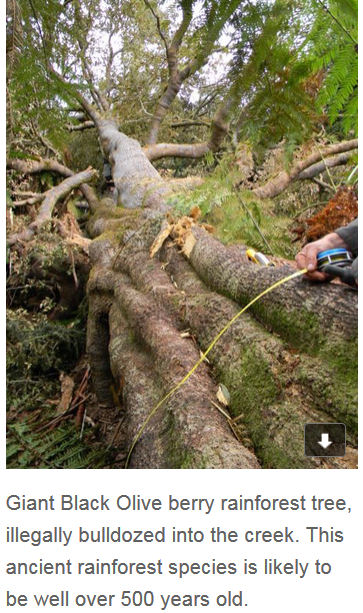
- Once the investigation concludes, the government need to prosecute VicForests for breaking our state environment laws.
In your letters it's important to emphasise that VicForests are the problem here. The Minister's department enforces laws to protect rainforest but the rogue forest agency of VicForests think they don't need to obey them. They must be prosecuted and the logging must be stopped.
Our rainforests are unique, rare and precious and illegal logging of them by VicForests is an abomination that flies in the face of state environment laws. This sort of reckless destruction doesn't belong in the 21st century.

Thanks for taking action. You have the power to stop the destruction and if we all join our voices and make ourselves heard we can get the loggers out.
For the forests,
GECO - Goongerah Environment Centre.
 "I am writing to express my serious concerns regarding the proposed VCAT fee increases. I believe these fee increases will unfairly hurt everyday Victorian residents, by undermining access to, in the words of VCAT’s motto, ‘Fair, Efficient Justice for all Victorians’" (Kelvin Thomson MP to the Victorian Attorney General.)
"I am writing to express my serious concerns regarding the proposed VCAT fee increases. I believe these fee increases will unfairly hurt everyday Victorian residents, by undermining access to, in the words of VCAT’s motto, ‘Fair, Efficient Justice for all Victorians’" (Kelvin Thomson MP to the Victorian Attorney General.)
[Letter from] Kelvin Thomson MP, Federal Labor Member for Wills
Tuesday 15th January 2012/ac
[To:]
The Hon Robert Clark MP Victorian Attorney- General Level 26, 121 Exhibition Street MELBOURNE VIC 3000

Dear Attorney-General,
Thank you for the opportunity to make a submission to the Regulatory Impact Statement for proposed Victorian Civil & Administrative Tribunal (VCAT) Fees Regulation Review (VCAT 2013).
I am writing to express my serious concerns regarding the proposed VCAT fee increases. I believe these fee increases will unfairly hurt everyday Victorian residents, by undermining access to, in the words of VCAT’s motto, ‘Fair, Efficient Justice for all Victorians’ (VCAT 2013A).
By increasing the financial barriers for Victorians to access VCAT, the justice system will lock out Victorians who cannot afford large fees and assist those who do have the money to fight legal cases, namely property developers and big business.
I believe these fee increase proposals are out of step with community expectations, are out of step with a fair and equitable justice system, and will play into the hands of property developers.
I have outlined steps I believe the Victorian Government should consider in making VCAT fairer and more accessible, rather than engage in fee hikes.
The Victorian Government states that the previous Government failed to keep VCAT fees in line with the cost of running the Tribunal, and failed taxpayers. The fee changes aim to reduce the burden on taxpayers and reinstate a ‘reasonable balance’ between taxpayer and user funding. The proposed changes expand the two-tier model for major cases, which allows some users to pay more to have a matter heard faster (Hudson 2013).
In my submission, however, VCAT’s establishment never intended that fees should cover the costs of running the tribunal, but rather fees and red tape are limited as to not prevent Victorians from accessing affordable and efficient justice.
Since its inception, VCAT’s (2012:2) purpose has been to provide Victoria’s with a low cost, accessible, efficient and independent tribunal delivering high quality dispute resolution.
The proposed changes would mean that the cost of launching small claims, planning appeals, tenancy disputes, and many other matters would accelerate from March under a planned expansion of the user pays system. VCAT is expected to collect an extra $22 million over the next 3 years from proposed fee increases and new charges (Hudson 2013).
The Victorian Government states that it proposes to recognise the mix of public and private benefits of the activities provided by VCAT, consistent with the approach taken in setting Victoria’s courts, by setting cost recovery for VCAT at 45% on average, of current expenditure in government appropriation funded lists. Currently VCAT only recovers costs ot an average 14% in these lists (Jaguar 2012:5).
I understand that revenue generated by VCAT’s Planning and Environment List if these changes proceed, will be in the vicinity of 44%, with revenue from year estimated to be over $2.7 million, in year two $3.2 million, and in year three $3.8 million (VCAT 2013:7).
If imposed, the fee increases would be higher than any other Australian state, affecting up to 8,000 Victorians per year. Under the proposed increases;
• The cost of lodging small claims over faulty goods will increase from $38 to $160
• Planning applications would attract an additional $1,000 fee, up from $322.
• Cases heard over more than one day will attract a new $1,800 a day fee (Pakula 2013).
The proposed fee changes mean that from March, fees to lodge an objection with the tribunal would quadruple from $322 to $1,462 for a development costing between $1 million and $5 million. By 2015 the fee would rise to $2,014. Developments costing more than $5 million would increase from $1,290 to $1,462 (Tran 2013).
I am particularly concerned that fees for planning appeals are much higher than other forms of appeals. Why is this the case? The higher fees for planning appeals act as a barrier to local residents and communities being able to effectively exercise their right to decide what kind of neighbourhood or community they live in.
VCAT should not be about revenue raising. VCAT should remain as the low cost dispute resolution body it was always intended to be.
Pursuing justice will cost more from March and would skyrocket in two years’ time (Gough 2013). Fee increases of this magnitude will discourage future VCAT applications from lodging claims before the tribunal (Pakula 2013).
Many Victorians will be denied access to justice under these planned fee hikes. The whole point of VCAT is to be a low-cost, easy-to-use alternative for Victorians, to give them a chance when they’re dealing with dodgy traders or shonky businesses. It would be a terrible shame if Victorians can no longer enforce their rights because they are priced out of it (The Australian 2013).
Yarra Mayor, Jackie Fristacky, and Protectors of Public Lands spokeswoman, Julianne Bell, have raised concerns that fee increases would restrict the accessibility of the tribunal to individual residents and resident associations. High fees are likely to inhibit people from appealing, yet the cost of planning appeals is already prohibitive for residents (Price 2013).
Save our Suburbs President, Ian Woods, says groups with fewer objectors would be hardest hit. Developers continually tend to resort to using lawyers, meaning the tribunal’s legal system is becoming more costly over time (Tran 2013).
Demand for community and legal aid services, and access to justice, is on the rise, illustrating that Victorians need to be provided with fewer barriers, not more, to access justice. Victorian Legal Aid (2011-12) has reported a 2% increase in the number of clients contacting them for assistance, up from 89,255 in 2010-11 to 91,079 in 2011-12. There has been an increase of 2% in the number of clients they support with no incomes. Overall 3 in 10 clients of Legal Aid had no income, 1 in 2 were receiving some form of government benefit or pension, 1 in 5 were from linguistic and culturally diverse backgrounds, 7% were in custody, 1 in 8 were under the age of 19 years, 2% were homeless and 3% were of Aboriginal or Torres Strait Islander background.
I am very concerned that the increase in VCAT fees will greatly benefit and assist property developers, by preventing local residents and communities from having their say.
VCAT (2013B) states that planning matters are often difficult and can involve complex legal or planning issues and can involve numerous parties and objectors. VCAT is currently experiencing delays between 8-10 months from commencement to hearing for planning and environment matters.
VCAT (2012:5) has reported that it received a 3% increase in the number of cases lodged, 89,470 in 2011-12, compared to 86,890 in 2010-11. Residential development proposals continued to be the subject of the majority of applications dealt with by VCAT’s (2012:32) Planning and Environment List, and in 2011-12 were have reported to have increased by 3% to 3,873 cases, compared with 3,775 in 2010-11 (VCAT 2012:5).
VCAT (2012:32) has reported that Planning and Environment cases are increasing in complexity due to the more complex and detailed policy framework. For example, planning strategies encourage high-density development close to activity centres which have resulted in more applications for large residential buildings in areas new to high-density living.
Applications involving developments worth approximately $6.39 billion were initiated in 2011-12. VCAT (2012:32) finalised 3,718 matters in 2011-12, a 6% increase in finalisations, with the list having a clearance rate of 96%.
In my own electorate of Wills, I have been supporting residents to oppose inappropriate developments in their neighbourhoods for many years. I believe that local residents should be given a meaningful opportunity to object and oppose inappropriate developments in their neighbourhood.
I support residents who approach me with genuine concerns about high density development proposals in their area, and fight for their voice to be heard in the planning process.
In July 2009 I lodged a detailed 30 page submission to the Victorian Government’s Melbourne at 5 Million Review, in which I specifically recommended that Melbourne’s population needed to be stabilised, and that the State Government and local councils should extensively consult with, and respect the views, of local communities on planning issues.
I have assisted, supported and lodged objections on behalf of residents in relation to numerous planning issues across Wills.
In some cases Moreland Council listened and respected the views of local residents, but in others residents continued their fight to oppose developments at VCAT. For those who did appeal decisions to VCAT, residents had to work hard to organise and raise money to support their appeals, through fundraisers, sausage sizzles and other avenues. For those who did not appeal unfavourable decisions, it was reported to me that existing VCAT fees were a significant barrier.
Property developers have the capacity to claim VCAT expenses as a tax deduction, in the context of their business dealings and operations. Residents, on the other hand have no capacity to claim any such expenses, despite the fact they are likely to be much more affected by a development than the developers.
The Government should not increase VCAT fees. It should work to make the existing planning framework and appeals process a great deal fairer for local residents, so that their views are proactively sought, listened and adhered to through planning and development decisions across the state. Property developers should not be given the green light to continue ramming down the throats of Victorians a proliferation of high rise, high density, concrete monstrosities that are clogging the arteries of Melbourne and increasing our carbon footprint.
I ask that you consider the information contained in my submission in the context of making Melbourne more liveable. I look forward to your consideration and response.
Yours sincerely
[Signed: Kelvin Thomson]
Federal Member for Wills
Cc: VCAT, The Hon Ted Baillieu MP, The Hon Martin Pakula MP, The Hon Daniel Andrews MP.
- The Australian(2013) ‘VCAT hikes will price out Victorians: Oppn’, published in The Australian 8/1/13 [Online] http://www.theaustralian.com.au/news/breaking-news/vcat-hikes-will-price-out-victorians-oppn/story-fn3dxiwe-1226549606147 [Accessed 9/1/2013]
- Gough, D. (2013) ‘VCAT fees set to rise’, published in The Age 8/1/13 [Online] http://www.theage.com.au/action/printArticle?id=3937023 [Accessed 14/1/2013]
- Hudson, P. (2013) ‘Victorians may be priced out of justice as VCAT fees soar’, published in Herald Sun 8/1/13 [Online] http://www.heraldsun.com.au/news/law-order/people-priced-out-of-vcat/story-fnat79vb-122654916828 [Accessed 14/1/2013]
- Jaguar Consulting (2012) Regulatory Impact Statement; VCAT Tribunal (Fees) Regulations 2013. Prepared for the Victorian Department of Justice [Online]
b5af056866ea/risvcatfeesregs2013.pdf”> http://www.justice.vic.gov.au/resources/bbac26af-4d92-4c42-82d0-
b5af056866ea/risvcatfeesregs2013.pdf [Accessed 14/1/2013]
-Lee, J. (2012) ‘Minister sidesteps VCAT’, published in The Age 4/10/12 [Online]
http://www.theage.com.au/victoria/minister-sidesteps-vcat-20121003-27031.html
[Accessed 14/1/2013]
- Pakula, M., The Hon. (2013) ‘VCAT Fees set to skyrocket under Baillieu
Government’, Media Release issues 8/1/13 [Online]
http://www.danielandrews.com.au/media/releases/vcat-fees-set-to-skyrocket-under-baillieu-government/ [Accessed 14/7/2013]
- Price, N. (2013) ‘VCAT fees not appealing’, published in Melbourne Leader 14/1/13 [Online] http://melbourne-leader.whereilive.com.au/news/story/vcat-fees-not-appealing/ [Accessed 14/7/2013]
- Tran, D. (2013) ‘VCAT fee hike eliminates ‘cheap option for appeals’, published in Dandenong Journal 14/1/13 [Online]
http://www.dandenongjournal.com.au/story/1229869/vcat-fee-hike-eliminates-cheap-option-for-appeals/ [Accessed 14/1/2013]
- VCAT (2013) Regulatory Impact Statement for proposed Victorian Civil &
Administrative Tribunal Fees Regulation Review (2013) [Online]
http://www.justice.vic.gov.au/home/the+justice+system/regulatory+impact+statement s/ris+for+proposed+vcat+fees+regs [Accessed 14/01/2013]
- VCAT (2013A) ‘Fair, Efficient Justice for all Victorians’ [Online]
http://www.vcat.vic.gov.au/ [Access 14/1/2013]
- VCAT (2013B) ‘Frequently asked questions re delays in Planning and Environment List’ [Online] https://www.vcat.vic.gov.au/disputes/planning-and-environment/news/delays-planning-and-environment-list [Accessed 14/1/2013]
- VCAT (2012) VCAT Annual Report2011/2012 [Online]
http://www.vcat.vic.gov.au/files/VCAT%20Annual%20Report%202011% 20-%2012.pdf [Accessed 15/01/2013]
- Victorian Legal Aid (2012) Annual report 2011-12 [Online]
http://www.legalaid.vic.gov.au/annualreports.htm [Accessed 15/1/2013]
Kelvin Thomson MP Federal Labor Member for Wills
 VCAT is proposing draconian fees on citizens who wish to protect their property and environment from undemocratic corporate backed development and overpopulation. Fees for a citizen lodging an objection to any development in 2012 were $38.80. For 2013 fees are proposed to rise to $731.80 (for developments costed at less than $1.0m) and to $1,462.30 for developments estimated at $1.0m or more. These fees would increase even more in 2014 respectively to: $869.60 and $1,737.90, and, in 2015, respectively, to $1,007.40 and $2,014.80. Add to this the cost of hiring barristers and this will make a complete mockery of democracy, which is already a laughing stock in Victoria anyway.Submission deadline is 5pm Friday 15 February 2013.
VCAT is proposing draconian fees on citizens who wish to protect their property and environment from undemocratic corporate backed development and overpopulation. Fees for a citizen lodging an objection to any development in 2012 were $38.80. For 2013 fees are proposed to rise to $731.80 (for developments costed at less than $1.0m) and to $1,462.30 for developments estimated at $1.0m or more. These fees would increase even more in 2014 respectively to: $869.60 and $1,737.90, and, in 2015, respectively, to $1,007.40 and $2,014.80. Add to this the cost of hiring barristers and this will make a complete mockery of democracy, which is already a laughing stock in Victoria anyway.Submission deadline is 5pm Friday 15 February 2013.

The government is trying to act to protect the interests of developers and their overwhelming vested interest in unwanted population growth by restricting peoples access to their own courts and tribunals through the imposition of draconian fees. The fact is that so many 'developments' (multiple new structures with costly impacts) are being forced on the people of Melbourne and Victoria that their objections are clogging up VCAT. Although VCAT stands for the Victorian Civil and Administrative Tribunal, instead of heeding democratic objection and curbing this remorseless overdevelopment, the government is attempting to stop democratic objections by making them too costly for citizens to bring about. This is a total scandal and if the government succeeds in removing most peoples' ability to influence what happens around them to their environment, there will be very little left that it will feel that it cannot do. Making government for big business is a major part of fascism, as is removing access to the law for communities. The only thing lacking now is overt violence against citizens.
Here is information regarding the proposed fee increases at VCAT (they want to cover part of their costs). Submissions are invited on the attached Regulatory Impact Statement no later than 5pm Friday 15 February 2013. Information on how to make a submission can be found here: http://www.justice.vic.gov.au/home/the+justice+system/regulatory+impact+statements/ris+for+proposed+vcat+fees+regs.
Go to the Regulatory Impact Statement, near the bottom of the page.
It could see an objection against a development valued at over $1m go from the present $38.80 to $2,014.80. Obviously a massive cost impost on any affected person objecting to a development
For example, page 13 0f the Regulatory Impact Statement, dealing with an increase in fees for the years 2012, 2013, 2014, & 2015:
1. If the proceedings are in respect of a development of any kind where the estimated cost of the development is less than $1 million
(2012) $38.8 (2013)$731.8 (2014)$869.6 (2015)$1,007.4
2. If the proceedings are in respect of a development of any kind where the estimated cost of the development is $1 million or more
(2012) $38.8 (2013)$1,462.3 (2014)$1,737.9 (2015)$ 2,014.8
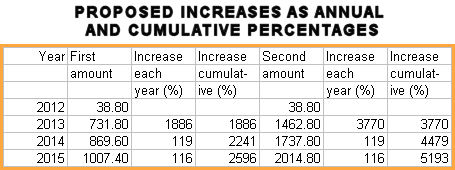
To put these increases in percentages really highlights how out of proportion they are - an indication of how out of proportion population growth and overdevelopment are in Victoria.
Kelvin Thomson’s submission re this matter:
http://www.kelvinthomson.com.au/Editor/assets/public_docs/2013/130114%20vcat%20kt%20submission.pdf
The Age article on the fee increase is here: http://www.theage.com.au/victoria/vcat-fees-set-to-rise-20130108-2cdtr.html.
The Herald Sun article on the fee increase is here: http://www.heraldsun.com.au/opinion/vcats-win-is-peoples-loss/story-e6frfhqo-1226549124582
What we have here in Victoria - and the same thing is happening Australia-wide - is a small set of people who happen to have been able to get financial domination of institutions and land-use planning and who are now using the parliament and the law to get whatever they want by depriving all the other citizens of their democratic right to self-government and control over their environment. Another name for this power-elite is the Growth Lobby.
 Is the Department of Planning in the Victorian State government vital to our lives or is it just part of endless population growth ? The Planning Department operates with a seemingly remarkable ignorance of the realities of resource (especially oil) depletion, some apprehension of climate change, scant reference to the environment, and no mention of creatures other than humans. Something funny's going on.
Is the Department of Planning in the Victorian State government vital to our lives or is it just part of endless population growth ? The Planning Department operates with a seemingly remarkable ignorance of the realities of resource (especially oil) depletion, some apprehension of climate change, scant reference to the environment, and no mention of creatures other than humans. Something funny's going on.
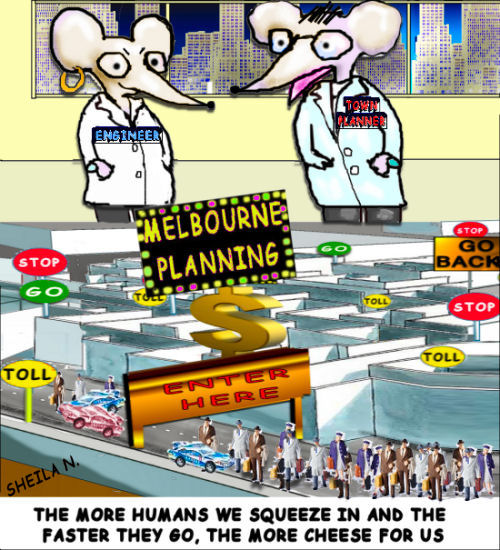
A friend and I recently were discussing disconsolately the current Victorian State Minister for Planning’s zone reforms and the department’s Metro Planning document "Melbourne, Let’s talk about the future." The purpose of both seem to be to facilitate more development, to make life easier for developers and to remove obstacles. I maintained that the more development that is allowed, the more disruptive the activities will be and the less certainty residents of Melbourne will have of the continuing amenity of their surroundings. Au contraire, they will live with the certainty that their amenity will decline.
My friend tends not to be rebellious but, like a lot of people, can see that there are powers behind the scenes at work in our lives. She came out very firmly saying, “Well you’ve got to have planning, other wise you will end up with a hotch-potch of development." The more adamant she was about this, the more I wondered if what she said was indeed true.

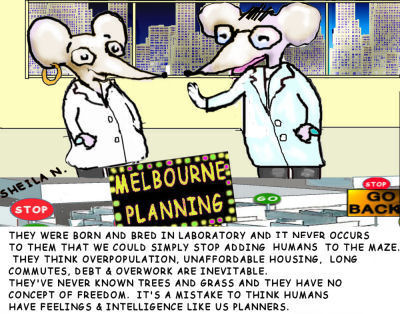
Planning in its current form seems to be all about accommodating population growth. It is about more and more human activities, buildings, roads, bridges houses. But does planning need to be exclusively about more of us and more of what we do, continually modifying our natural environment and pushing out other species?
What would our Department of Planning do if growth was slow or non existent? Would the planning Department be able to justify its existence? What sort of changes would then need to be planned for? There could be changes in the age structure of the population which might require different services. But are these the domain of the planning department? Couldn’t the Department of Human Services take care of this? Then there are changes to the types of energy sources that must be provided. Energy is privatized in Victoria but the Department of Primary industry now has the role of overseeing energy distribution and invests in new technologies (according to its website).
Because of past and present population growth, Victoria and all of Australia is way behind with infrastructure provision, so the Planning Department could put their minds to this and, for the first time in our lives, we might be adequately provided for in this respect. Or could an ‘Infrastructure department” take care of that? With a stable or near stable population, houses would still need to be built for a time as there are not enough roofs to cover the heads of the current population. Could the Planning department focus on that? Or would housing be best in the hands of the Department of Human Services? It is after all a basic human need. It would not make a terribly impressive glossy coloured document, but the homeless would be impressed.
With rapid population growth as we have suffered for the last decade, which of the State government ministers gets the most press attention? I think it is the Planning Minster. This attention is not a compliment to him nor to his predecessor though. They both hit the news because development decisions are controversial and permanent in nature with a few winners and many more losers.
With a stable or very slowly growing population, planning would no longer be “famous” as it is now in Victoria. Would it even be necessary as a separate entity?
Those in power need to look to the future because they make decisions that endure long term. The Planning department seems to respond to the greed and desires of the growth lobby by facilitating growth. With superficial buzzwords and motherhood statements in the document “Melbourne, let’s talk about the future,” the Planning department foreshadows a real shock for residents of regional towns such as Geelong and Ballarat. With the mantra, “Planning for regional city growth is vital,” the Department glibly writes off our future hope of livability by embracing growth like an adored relative and with a seemingly remarkable ignorance of the realities of resource (especially oil) depletion, some apprehension of climate change, scant reference to the environment, and no mention of creatures other than humans.
Sheila Newman has just published new theory in a new book, Demography, Territory & Law: The Rules of Animal and Human Populations (see link). Forensic biologist, Hans Brunner writes of it: "This book takes us to a completely new paradigm in multiple species population science. It shows how little we understand, and how much we need to know, of the sexual reactions when closed colonies with an orderly reproduction system are destroyed, be it people or animals." Two chapters are on multi-species demography, the rest apply the theory to non-industrial societies and the author comes up with a completely new test for the collapse model of Easter Island, which will stun those who thought they knew all about it.
“You’ve got to have Planning” (with a capital P)?
Let’s try life without it.
 Sheila Newman will interview Jenny live 19 April between 12 midday and 1pm at 3RPP. You can listen live here. What next? Will they sell the people off as slaves? Will the remove access to our bank accounts overnight? Will they raise the cost of electricity so high that the companies take our houses to pay for them? Our Parliamentary system is beyond democratic control. Our economic system is a bad joke. Our taxes are used to pay for educational institutions which are then set up to profit private enterprise and investors and users overseas. And now, under Ted Baillieu, there is this proposal to sell Port Melbourne... (No, this is not an April fools joke.)
Sheila Newman will interview Jenny live 19 April between 12 midday and 1pm at 3RPP. You can listen live here. What next? Will they sell the people off as slaves? Will the remove access to our bank accounts overnight? Will they raise the cost of electricity so high that the companies take our houses to pay for them? Our Parliamentary system is beyond democratic control. Our economic system is a bad joke. Our taxes are used to pay for educational institutions which are then set up to profit private enterprise and investors and users overseas. And now, under Ted Baillieu, there is this proposal to sell Port Melbourne... (No, this is not an April fools joke.)

"It’s insulting that Spring Street might value the Port of Melbourne at only $2.4 billion (Baillieu flags state asset sales 23/3). Taxpayer shareholders recently spent around $1 billion on channel deepening and subsequent maintenance dredging to “prepare the Port for the future”. And, it’s a small fraction of the current estimate of $10 billion to develop the Port of Hastings – a project recently identified by government as urgently needed infrastructure. Taxpayers have invested in the Port of Melbourne for over a century and now we are expected to support its hand over to the private sector and then pay again to build Hastings port. It’s time to join the dots. Dumping the Port of Melbourne and developing Hastings is about catering for Baillieu’s pet projects for Gippsland: export of brown coal, woodchips and coal seam gas it he can find it. Topped up with Ports Minister Napthine’s proposed driverless trucks trundling up the Westernport Freeway from the Port of Hastings with assorted imports and we are approaching dystopia indeed."(Jenny Warfe, Blue Wedges) Sheila Newman will interview Jenny live on 19 April between 12 midday and 1pm at 3RPP. You can listen live here.
(Originally published March 27 2012 on 3RPP as "Sale plan to pay for port."and in Western Port News, 27 March 2012.)
March 27 2012
THE state government could sell the Port of Melbourne for $2.4 billion and four water authorities to fund five priority infrastructure projects including development of the Port of Hastings.
The other four projects are the east-west tunnel (linking the Western Ring Rd and the Eastern Freeway), rail links to Avalon airport, duplication of major freight highways, and a rail tunnel from Caulfield to Footscray.
Last financial year the port paid a dividend of $13.4 million to the government and earned an after-tax profit of $39 million.
Melbourne’s four water authorities are Melbourne Water, City West Water, South East Water (which services the peninsula) and Yarra Valley Water.
The revelation of the government’s plans for possible asset sales has already drawn criticism from disparate sources including award-winning economics and public policy commentator Ken Davidson and environmentalists.
Mr Davidson wrote on Monday that it was “silly to prioritise the port at Hastings while Australia’s number one port at Melbourne has serious problems that inhibit Victoria’s development”.
Industry groups, including the Australian Peak Shippers Association, have warned the Port of Melbourne would face major bottlenecks from 2015 onwards as it reached capacity.
This has seen the government, led by Ports Minister Denis Napthine, to promise fast-tracking of Port of Hastings development (‘New port start five years away’, The News, 31/1/12).
In January Mr Napthine and Port of Hastings Development Authority board chairman Yehudi Blacher told The News Hastings was well suited to become Victoria’s second container port within 10 to 13 years.
“Container movements are estimated to quadruple over the next 30 years and it is critical that we begin planning for this growth now,” Mr Napthine said.
But Mr Davidson says development of Hastings could wait until 2035 when Melbourne’s population was expected to be five million.
Until then, the Port of Melbourne could be improved by redeveloping the Swanson/Dynon precinct, he said.
Other suggestions have included developing Webb Dock.
The pressure on Port of Melbourne has further increased following claims by government sources, port figures and shipping and automotive industry groups that the government is set to abandon its plan to move all automotive shipping from Melbourne to the Port of Geelong.
Port of Hastings has been touted as an alternative port for exporting and importing vehicles, especially with the closure of BlueScope’s hot strip mill, which saw the Iron Monarch bringing slab steel from Port Kembla weekly.
The Iron Monarch’s last voyage of slab cargo arrived at Western Port on Tuesday 4 October and the BlueScope jetty is underutilised.
Selling the Port of Melbourne and developing Hastings was about catering for Premier Ted Baillieu’s pet projects for Gippsland – exporting from Western Port brown coal, woodchips and coal seam gas, Blue Wedges Coalition president Jenny Warfe told The News on Monday.
Ms Warfe said it was insulting the government valued the Port of Melbourne at only $2.4 billion.
“Taxpayers recently spent about $1 billion on channel deepening and subsequent maintenance dredging to ‘prepare the port for the future’, as port authorities claimed,” she said.
“The current estimate to develop the Port of Hastings – a project recently identified by the government as urgently needed infrastructure – is $10 billion.
“Taxpayers have invested in the Port of Melbourne for more than a century and now we are expected to support its hand over to the private sector and then pay again to build Hastings port?
“It’s time to join the dots. Dumping the Port of Melbourne and developing Hastings is about the premier wanting to export from Gippsland brown coal, woodchips and coal seam gas, if he can find it.
“With massive trains hauling this cargo through our green wedges to Hastings – and Ports Minister Denis Napthine’s proposed driverless trucks trundling up the Western Port Freeway from the Port of Hastings with assorted imports – we are approaching dystopia indeed.”
The government last month introduced laws forcing the Port of Melbourne Corporation to pay an annual $75 million ‘’licence fee’’ that would increase each year with inflation and generated about $1 billion over the next decade.
The Port Licence Fee will add $8000 to $10,000 to the cost of bringing a ship into the Port of Melbourne.
The fee cuts both ways as the Victorian Farmers Federation says it will add $10 million to the cost of exporting Victorian farm produce. It has dubbed the fee a “tax on trade”.
Melbourne has the last publicly owned major port on the eastern seaboard following the Queensland government’s sale of the Port of Brisbane for $2.1 billion and a NSW government plan to privatise Port Botany.
 Victorian Planning Minister Matthew Guy is setting up a website http://www.planmelbourne.vic.gov.au asking for residents' feedback on the sort of Melbourne we want in the future. These kinds of websites, however, make it hard to say what you really think. It is probably better to send the Minister a submission re Plan Melbourne saying what you really think, in your own words, rather than responding to the website questionnaire. Email it to Matthew.Guy[AT]parliament.vic.gov.au . As a guide, we suggest that any plan must first have a policy to limit the population growth. To ignore this issue and try to plan for greater growth, would be self defeating.
Victorian Planning Minister Matthew Guy is setting up a website http://www.planmelbourne.vic.gov.au asking for residents' feedback on the sort of Melbourne we want in the future. These kinds of websites, however, make it hard to say what you really think. It is probably better to send the Minister a submission re Plan Melbourne saying what you really think, in your own words, rather than responding to the website questionnaire. Email it to Matthew.Guy[AT]parliament.vic.gov.au . As a guide, we suggest that any plan must first have a policy to limit the population growth. To ignore this issue and try to plan for greater growth, would be self defeating.
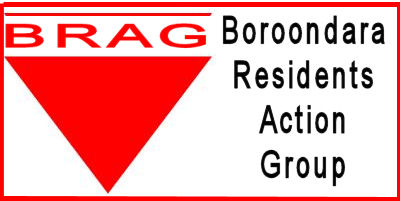
The Department of Planning has been working on a new metropolitan planning strategy and regional growth. A press release today from the Minister of Planning says, “We need to build on the best of past planning strategies and bring fresh thinking to our consideration of projected growth and change and how we address the challenges in front of us”.
But Brag's Vice President, Mary Drost, has responded saying,
“Population has grown too fast and infrastructure hasn’t been able to keep up.”
She is quite right. Melbourne is the fastest growing city in Australia, we grew by about 605,000 from 2001 to 2010 compared with only 450,000 in Sydney and that trend continues. And we are under pressure with overcrowded transport, gridlock on our freeways, overloaded sewerage and drainage, water shortages, power blackouts, problems with schools, hospitals etc.
The current planning strategy is to retrofit development into existing areas using existing capacity in schools, hospitals roads, rail,
trams etc. but any capacity is now well and truly filled. For instance our trains and trams are already seriously overcrowded.
BRAG's view is that any proposed development should identify local infrastructure capacities, show the effect of the project and how the developer will tackle the problems that will arise. If the developer does not come up with a satisfactory solution then the application should automatically fail. It should not fall back on Councils or the residents to rectify such problems.
Outer suburban developers have long been required to fund local infrastructure requirements. Why not in the inner suburbs?
BRAG contends that a bigger Melbourne is not a better Melbourne. We are trying to cope with densification in inner Melbourne as well as the urban sprawl and neither option is the answer. The Federal budget is unlikely to provide finance for the necessary infrastructure upgrades. Of course we have the elephant in the room – massive population growth, which both federal and state governments ignore.
So what is the answer?
We are constantly told that we need to go up to cope with population growth . Commentators like Bernard Salt from KPMG and the
Committee for Melbourne believe Melbourne needs New York style development and have promoted “Manhattanising” Melbourne,
which appeals to the development and construction industry but would be a disaster for residents.
Boroondara is a great place to live and, as a consequence, is under pressure from the developers because it offers them the best
economic returns. Our Council is doing its best to manage the tensions between accommodating growth and offering housing diversity while maintaining liveability. However the pressure from developers will continually increase making council’s task ever more difficult.
More and more residents from all over Boroondara are asking BRAG for help in combating opportunistic development in their area.
Under the previous state government there was a real decline in local democracy and local say in planning issues which accompany urban consolidation. When we object, we are branded NIMBY’s But its OK to say “not in my backyard”. We do have rights concerning the neighbourhood we live in despite what the growth lobby says.
Now we have an opportunity to exercise those rights. Planning Minister Guy has announced he is setting up a website http://www.planmelbourne.vic.gov.au which offers residents the opportunity to have input to the sort of Melbourne we want in the future.
We urge you to carefully consider the issues then go on to the website and tell the government what you think. Encourage your neighbours to do the same. If we don’t then the government will think we don’t care.
However, be careful about following the lead set by the questions. Like many such government surveys, they seem to be set up to gain predetermined answers.
BRAG believes it is better to send the Minister a submission re Plan Melbourne in your own words that say what you really think. Email it to Matthew.Guy[AT]parliament.vic.gov.au
As a guide, we suggest that any plan must first have a policy to limit the population growth. To ignore this issue and try to plan for
greater growth, would be self defeating but you make up your own mind and tell the government accordingly.
Jack Roach
BRAG(Boroondara Residents Action Group)
 Ratepayers have fewer and fewer rights in Victoria but it may be that they can refuse to pay their rates unless they are satisfied.
Ratepayers have fewer and fewer rights in Victoria but it may be that they can refuse to pay their rates unless they are satisfied.
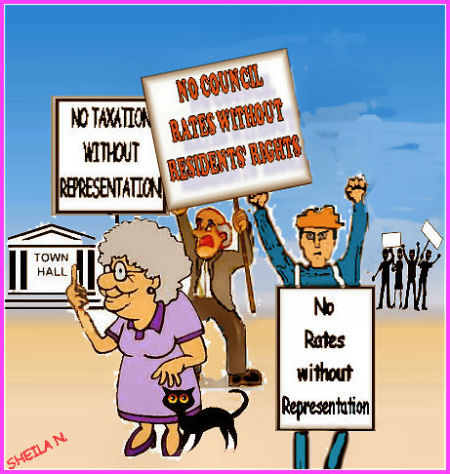
(As Reported on 3aw 15/3/12)
The State Government have submitted to parliament a law that council’s no longer have to advise abutting owners of a planning permit application or that the applicant must place a notice on the site.
This means that you will not be aware what is proposed next door nor will you have the option to object because the Planning application will have already been granted.
This is not in the best interest of Ratepayers or for local community, think about what this will mean.
If a councilor or a council officer or builder wants to have a planning application approved you will not know about the application, until the builders arrive.
There has been much debate on this issue.
Victorian Ratepayers Inc.(RPV) from the facts presented to our organisation it would appear that Council’s have no legal right to collect rates, consider the following facts.
There is a core issue for us all in Australia, and that is whether municipal councils have the power/authority to charge "rates". Please consider
- In 1904, the High Court of Australia determined that municipal "rates" are a tax.
- In 1988, the people of Australia voted in a referendum in relation to municipal councils being recognised in the Commonwealth Constitution as a third tier of government.
The vote was NO!!!
- In 2009, [Pape V Commissioner of Taxation] the High Court said that "responsible government" involved three fundamental principles.
- 1/ The passing of legislation to collect tax (as public money for public purposes),
- 2/ Money collected must go into a Consolidated Revenue Fund, and
- 3/ The Parliament MUST make Bills for approval of the spending of those funds .. to become Acts.
- Consider whether municipal councils are able to be held as "responsible government" from this fundamental legal standard!
Now, if councils are not lawfully authorised as a third tier of government in several States for several reasons. The tax they collect is not done with lawful authority.
The standard set for responsible government by the Rule of Law applying to this country is upheld by the High Court, and we need to ensure this occurs in-so-far-as "rates" are concerned.
Your views on this matter are invited .
Emails To jack_d[AT]iinet.net.au Email Jack
Source of article material: Ratepayers Victoria Inc., "March News letter 2012"
Email ; ratepayersvictoria@ gmail.com Phone 03 9570 6227
Postal Address 8/1248 North Road Oakleigh South 3167
Website: http://www.ratepayersvictoria.com.au

This audit assessed whether State Trustees is effectively managing the financial and legal interests of represented persons. It examined the extent to which State Trustees is meeting its legislative and administrative responsibilities, the systems and processes that enable State Trustees to measure quality, timeliness and cost effectiveness, and the adequacy of State Trustees' communication and accountability processes to represented persons. The audit found that State Trustees is not able to clearly demonstrate that it is fulfilling its obligations to represented persons. State Trustees’ direct engagement with represented persons is not sufficient for it to be assured that their needs and wishes are properly understood.
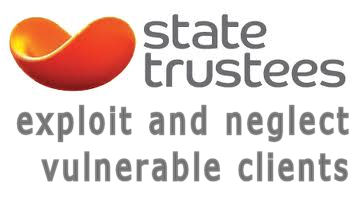
(Long report follows this summary).
Tabled: 8 FEBRUARY 2012
Represented persons are those deemed incapable of managing their own affairs due to disability, mental illness, injury or other incapacitating circumstances. They are considered to be among the most vulnerable members of the community. Under the Guardianship and Administration Act 1986 (the Act) represented persons are appointed administrators who must manage their legal and financial affairs while acting in their best interest. State Trustees Limited is the administrator for over 10 000 represented persons in Victoria.
This audit assessed whether State Trustees is managing the financial and legal affairs of represented persons in their best interests.
The audit found that State Trustees is not able to clearly demonstrate that it is fulfilling its obligations to represented persons. Its focus is on measuring its commercial success and it relies predominantly on compliance with its service contract with the state as a proxy for compliance with the Act. However, this does not demonstrate the quality or effectiveness of the management of represented persons' affairs and it does not have the robust governance, monitoring and reporting mechanisms needed to do so. There is also inadequate quality assurance and review of the services provided to represented persons.
State Trustees’ direct engagement with represented persons is not sufficient for it to be assured that their needs and wishes are properly understood. In addition, poor information management and high case manager turnover means that decisions about their affairs are not always based on complete or accurate information.
Victoria's Auditor-General, Des Pearson, this morning tabled the following report in the Victorian Parliament:
Ordered to be printed
VICTORIAN GOVERNMENT PRINTER February 2012
PP No 102, Session 2010–12
Dear Presiding Officers
Under the provisions of section 16AB of the Audit Act 1994, I transmit my report on the audit State Trustees Limited: Management of represented persons.
Yours faithfully
![]()
D D R PEARSON
Auditor-General
8 February 2012
Among the most vulnerable members of
the community, represented persons are those deemed incapable of managing their
own affairs due to disability, mental illness, injury or other incapacitating
circumstances. State Trustees Limited is the administrator for over 10 000
represented persons in Victoria. As administrator, State Trustees is obliged
under the Guardianship and Administration Act 1986 (the Act) to manage
the financial and legal affairs of represented persons while acting in their
best interests.
Victoria's ageing population is a key
challenge and priority for the community. By 2050 the estimated proportion of
the population aged 65 and above will be 23 per cent compared with 14 per cent
now, thus significantly raising the number of elderly people needing trustee
services. Continued growth is also expected in the demand for community
services with increasingly diverse and complex client needs. This will directly
impact on the demand for administration services by represented persons.
This audit assessed whether State
Trustees is managing the financial and legal affairs of represented persons in
their best interests.
State Trustees' focus is on measuring
its success in terms of its commercial strength. It gives less consideration to
whether it is meeting its obligations under the Act.
State Trustees' governance and control frameworks
align with better practice but flawed implementation, ineffective oversight,
and a failure to regularly and systematically test how effective controls are
in practice, limit the assurance it can provide to its board of governance
about organisational compliance and performance.
State Trustees has not appropriately
defined the services required to meet the Act's obligations, and its
performance management framework does not have the robust monitoring, measuring
and reporting mechanisms needed to track if it is effectively doing so.
Inadequate information management systems, combined
with high case manager turnover, means that decisions about represented
persons' affairs are not always based on complete or accurate information.
State Trustees' direct engagement with represented persons is also not
sufficient for it to be assured that their needs and wishes are properly
understood. There is also inadequate quality assurance and review of the
services provided to represented persons.
State Trustees relies predominantly
on compliance with the Community Services Agreement (CSA) with the Minister for
Community Services, as a proxy for compliance with the Act. But the agreement
is primarily concerned with service delivery, not service quality. As a result,
adherence to the CSA does not demonstrate either the quality or effectiveness
of the management of represented persons' legal and financial affairs.
Accordingly State Trustees is not able to
clearly demonstrate that it is fulfilling its obligations to represented
persons. Nevertheless, its new Business Process Management program, designed to
identify weaknesses in current business processes and practices, should lead to
a direct improvement in the quality of services delivered to represented
persons.
State Trustees' does not monitor its compliance with the
Act which sets out its key service obligations to represented persons.
Instead it relies on its procedures as its key operational
control in meeting service obligations. However, State Trustees has a
well-documented history of many of its procedures being out-dated, unused,
inadequate or non-existent.
Only one of State Trustees' 21 corporate objectives relates
to the quality of services provided to represented persons. Of the 58 corporate
performance indicators, three are linked to that objective. However, no
corporate performance reports include these indicators.
The 2004 risk management framework aligns with better
practice principles. However, it has not been fully implemented, or assessed
for effectiveness in managing risks relating to the estate administration of
represented persons.
To date State Trustees has undertaken only limited
performance benchmarking, particularly against other public trustees. It has
also recently changed its approach to the investment of client funds, which it
has yet to fully evaluate.
When evaluating the investment model, State Trustees needs
to consider how it meets its obligations under the Act to operate in the best
interests of represented persons.
Faced with ongoing issues of high case manager turnover,
unsustainable case loads and the demand for specialised staff, State Trustees
introduced the 'manageable caseload' project to improve competencies and
caseload balances.
The project improved in-house case manager workloads and
competencies, and its success led to an extensive in-house staff competency
program. However, high turnover continues and there is doubt about State
Trustees' ability to sustain the program in light of the increasing service
demand and complexity of client needs.
Reviews over the past five years have identified poor
information governance, the absence of a policy and framework for managing
information assets, and a general inability to meet government requirements for
managing records.
As it relies heavily on the information in its client
information management system to make decisions on behalf of represented
persons, its poor information management practices place the quality of those
decisions and its services at risk.
The inconsistent quality of client records has the
potential to compromise financial and legal decision-making, and backlogs in
preparing financial or investment plans can adversely impact investment
returns.
State Trustees is implementing an Electronic Document and
Records Management System.
State Trustees staff need to form and maintain good
relationships with clients, which is best done through regular personal
contact. However, after the mandatory visit within the first 65 days of appointment,
staff visit only 5 per cent of ongoing clients each year. Poor record keeping
of communication with clients means State Trustees cannot demonstrate it is
effectively engaging with its clients.
State Trustees has a stakeholder engagement strategy for
its commercial and community stakeholders and actively engages the community on
issues relevant to represented persons. However, the strategy does not
explicitly include clients and no client engagement strategy exists.
State Trustees' one corporate service delivery objective
for represented persons is to improve the results of the annual client
satisfaction survey, the Client Value Index. This survey is a valid measure of
client and carer perception of service delivery quality, but it is State
Trustees only measure of this. Internal analysis of service quality against
defined quality targets does not occur. In isolation, the survey cannot be used
to demonstrate whether State Trustees is acting in the best interests of each
represented person.
The Client Concerns Panel is effectively handling the small
proportion of serious and complex complaints. State Trustees needs to improve
its handling of the other types of complaints it receives. It does not
consistently use its client information system to manage complaints, preferring
to record them manually in a spreadsheet-based register and/or in hard copy
files. Internal reviews have identified inconsistent quality of complaint
information.
State Trustees does not adequately analyse complaints data
to discern trends, identify issues or target staff training, and does not seek
feedback on complaints processes or resolution. An internal audit in 2009
recommended it implement both these improvements.
That State Trustees:
In addition to
progressive engagement during the course of the audit, in accordance with
section 16(3) of the Audit Act 1994 a copy of this report was provided
to State Trustees Limited with a request for submissions or comments.
Agency views have been considered in reaching our
audit conclusions and are represented to the extent relevant and warranted in
preparing this report. Their full section 16(3) submissions and comments
however, are included in Appendix A.
Many Victorians are unable to manage
their own financial and legal affairs due to disability, mental illness, injury
or other circumstances. They are among society’s most vulnerable citizens.
Under the Guardianship and Administration Act 1986
(the Act), the Victorian Civil and Administrative Tribunal (VCAT) may order the
financial and legal affairs of these ‘represented persons’ to be managed on
their behalf by an administrator.
Under the Act, an administrator:
Section 49 of the Act requires an administrator to act in the
best interests of a represented person. This includes:
VCAT
determines an appropriate administrator for each represented person. Where
feasible and appropriate this is often a family member; in other circumstances
it may appoint a trustee. In many cases, this is State Trustees. Overall, State Trustees
acts as administrator for around 50 per cent of represented persons in
Victoria.
The Public Trust Office of Victoria was established in
1939, to protect the interests of Victorians, particularly those with
disabilities. It became administratively independent from government in 1987,
when it became the State Trust Corporation of Victoria.
In 1994, The State Trust Corporation of
Victoria became a company (State Trustees Limited). This was part of the
government’s objective to make state-owned businesses more efficient by
exposing them to competition from the private sector. The business activities
of State Trustees expanded to include providing financial and related services
to a wider market.
However, a substantial
part of State Trustees’ core business is administration of represented persons’
financial affairs and estates. In 2010–11, State Trustees acted as
administrator for over 10 000 represented persons. Its total client base was
over 18 000.
At 30 June 2010,
represented persons’ funds represented 53 per cent of the $796 million
total funds invested and managed by State Trustees.
State Trustees, like any
trustee acting as an administrator for represented persons, may charge for the
services provided.
In recognition that some
represented persons may lack the resources to obtain services, the State
Trustees (State Owned Company) Act 1994 makes the Minister for
Community Services responsible for ensuring that members of the public who do
not have the resources to manage and administer estates and property can
receive such services.
The minister may enter into
an agreement with a trustee company, person or body to provide these services.
For represented persons who are unable to pay for these services the agreement
provides for some or all of the costs to be met. A Community Services Agreement
(CSA) has been in place with State Trustees since 1994 and is renegotiated
every five years.
The CSA is not limited to
represented persons administration, but also includes community service
obligations in relation to other trustee services, deceased estate
administration, and attorneyships. However, services to represented persons
make up the large majority of services provided under the CSA.
The CSA requires State
Trustees to achieve specific minimum service or performance standards, to
report to the Department of Human Services (DHS) on the cost of services, to
maintain appropriate and relevant records for DHS, and to effectively manage
services for clients referred by VCAT.
DHS reimburses State
Trustees for the net costs of the services provided. State Trustees charges
those who can pay. Of the 10 000 represented persons for whom State Trustees
acts as administrator, around 8 500 are covered by the CSA.
In 2009–10, all
services provided to represented persons contributed $26.4 million (45 per
cent) towards State Trustees’ total revenue. Payments made under the CSA were
around $16 million.
The CSA obligations are separate and
additional to the obligation to act in the best interests of each represented
person, which is established in the Act and applies to all represented persons.
The CSA obligations do not displace this duty, and are not intended to
necessarily reflect what might be satisfactory performance in relation to
the Act.
State Trustees’ sole shareholder is the state of Victoria. Under the State
Trustees (State Owned Company) Act 1994, State Trustees reports through its
board of directors to the Treasurer.
Various committees oversee the organisation
and advise the board of directors on corporate risks. Figure
1A shows State Trustees’ corporate and business structure.
Figure 1A
State Trustees corporate and business structure

Source: Victorian Auditor-General’s Office.
The board delegates operations and
administration to the managing director who is supported by a corporate
leadership team and senior management group.
In total, State Trustees has seven
divisions, 26 business units and over 550 staff.
The Personal Financial Solutions
division is primarily responsible for the day-to-day administration of
represented persons’ estates.
The audit
objective was to assess whether State Trustees is effectively managing the
financial and legal interests of represented persons by assessing the:
extent to which State Trustees is meeting its
legislative and administrative responsibilities for represented persons
The audit was conducted in accordance
with the Australian Auditing and Assurance Standards.
The cost of the audit was $560 000.
The report is structured as follows:
State Trustees should be able to demonstrate that it
acts in the best interests of represented persons through effective corporate
governance frameworks that apply robust performance, risk, compliance and
financial controls to oversee and meet legislative, contractual, strategic
and operational goals.
State Trustees cannot assure itself that it acts in
the best interests of represented persons. Although its control frameworks
generally align with better practice, shortcomings in oversight and
implementation give only limited assurance that they are working as intended.
State Trustees does not monitor or measure its
compliance with the Guardianship and Administration Act 1986. It has
an underdeveloped performance management system. While it has a generally
sound risk management framework, it has not been fully implemented, and
outstanding concerns remain in relation to the assessment and detection of
fraud.
State Trustees has performed limited benchmarking of financial performance, but
plans to enhance this over the next 18 months.
That State Trustees:
include all legislative and contractual
obligations in its compliance framework and use the framework to monitor
compliance against these obligations
State Trustees should be
able to demonstrate it acts in the best interests of represented persons by
using appropriate governance and internal control
frameworks that focus on the best interests of represented persons, and then
subjecting these to regular testing and reporting.
Despite numerous internal and external reviews over
the past decade that identified shortcomings, State Trustees is not able to
demonstrate that it has adequate systems in place that ensure the best
interests of each represented person are being met. This is because it:
In May 2000 the Auditor-General tabled a performance
audit titled Represented Persons: Under State Trustees’ administration.
Since then State Trustees has been externally reviewed
several times. The reviews covered:
The reviews’ findings
indicated that State Trustees had improved its operations in general but
further work in these areas was still required.
Further, State Trustees’
Memorandum of Association focuses on its commercial imperative rather than its
duties as administrator for represented persons. While State Trustees’
predecessor body had specific legislative objectives to provide administration
services in accordance with the principles of the Act, State Trustees’ Memorandum
of Association sets out its principal objective as to perform its functions for
the public benefit by operating its business efficiently, consistent with
prudent commercial practice, and maximising its contribution to the economy and
wellbeing of the state.
Consequently over the past
15 years its corporate focus has been on its commercial imperatives rather than
its duties as administrator for represented persons.
Read together
with the Personal Financial Solutions (PFS)
Operational Plan
(2010–11), services provided to represented persons operate on a
commercial footing. State Trustees has recognised the need to adjust its
focus and to increase the emphasis at corporate level on meeting its community
service obligations. It has commenced discussions with the Department of
Treasury and Finance to reflect this in its Memorandum of Association.
State Trustees does not monitor compliance with the
Act, instead using its internal procedures as a key operational control to meet
its obligations to represented persons.
The compliance management framework is generally
aligned with best practice. A compliance committee is responsible for
managing compliance and each division is responsible for implementing the
framework. However, the committee does not monitor or report on compliance with
the Act; rather, it monitors and reports on compliance with the CSA.
In 2008, State Trustees’ internal auditors reviewed
the compliance policy and framework, noting there was no regular compliance
monitoring at corporate and divisional levels. It did not assess whether the
divisions were implementing the framework effectively.
Administrative practices for represented persons are
described in over 100 policies, procedures, templates and tools. There are gaps in relevant policies and procedures, with some that are
inadequate, incorrect, out-dated or not followed.
State Trustees is neither monitoring,
measuring nor reporting on the effectiveness and quality of its performance in
administering estates for represented persons.
State Trustees’ corporate performance management
framework has 58 KPIs in the five key result areas of:
Although the areas of growth, financial sustainability
and people potentially affect State Trustees’ capacity and capability to
deliver effective estate administration services, the associated KPIs do not
measure the quality of these services.
KPIs for client and community engagement measure
promotion of client interests to commercial and community stakeholders. They do
not measure how well they are engaging with their clients.
Only three of the 58 KPIs measure service quality,
namely:
State Trustees has yet to introduce the client
service framework scheduled for 30 June 2011. It has therefore not
yet effectively defined:
the specific services represented persons
require and how best to deliver them
The PFS division, responsible for administering
represented persons’ estates, provides monthly performance reports to senior
management covering divisional revenue and costs. It also includes information
on such things as the number of new and deceased clients, its ‘market share’ of
represented persons, and its commission from the sale of client properties.
Reporting on service quality is restricted to performance against the CSA. The
Department of Human Services accepts that reporting against the CSA does not
address the effectiveness or quality of services for represented persons.
Monthly performance reporting from the PFS division’s
business unit managers to the PFS General Manager is via two key reports. The
first contains data on the number of activities completed and outstanding, and
the second contains commentary on those activities. These reports are not
supported by qualitative data or analysis of whether State Trustees is meeting
its obligations under the Act.
State Trustees does not have defined standards for all of
the services it needs to provide to meet its obligations for the administration
of represented persons’ estates. Because of this it also does not have
performance targets and monitoring programs to measure and report on whether
these obligations have been met. State Trustees’ relies on compliance with the
CSA as a proxy for assessing whether it has met its obligations under the Act.
State Trustees has recently commenced a Business Process
Management (BPM) program to strengthen business processes and improve its
efficiency and effectiveness. The March 2011 BPM report recommended a focus on
client needs and the use of risk management, compliance management and the
development of business rules to ‘ensure our client needs are met’.
Administration in the best interests of represented
persons requires effective identification, assessment and management of risks.
State Trustees’ risk management framework aligns with
better practice principles but has not been fully implemented in the divisions.
In addition, numerous internal and external review recommendations and two
recent serious fraud incidents have pointed to the need for more rigorous risk
management.
The risk management framework gives overall responsibility
to a Risk Committee of Management (RCoM) and requires divisional managers to
confirm every six months that ‘all risks have been adequately identified,
reported and reviewed with all actions being performed in an appropriate time
frame’.
The framework’s effectiveness has not been assessed
since it was set up in 2004 although State Trustees says that an internal
analysis done in 2010 suggests it is effective. However, there is no
documentation of this review to demonstrate that this analysis assured the
framework’s effectiveness.
In September 2009, following an internal review of
risks in the PFS division, RCoM advised State Trustees’ board that all 12 of
the most serious risks related to represented person estate administration in
the division were not properly mitigated.
Shortly afterwards, RCoM decided not to conduct a
further review of these divisional risks until after State Trustees had aligned
its risk management framework to the new best practice standard. The alignment
was completed in August 2011.
Other than for recruitment and competency development
activities, State Trustees’ risk management records show no evidence that these
risks or their related controls have been monitored or reported on between the
2009 review and the 2011 realignment.
A 2011 internal audit of the PFS new client team found
deficiencies in the monitoring of improvement initiatives, the use of
procedures designed to improve the quality of client information, record
keeping of quality review activities and the team’s policies and procedures.
The State Trustees’ fraud prevention and detection
framework is based on a model that aligns with better practice. However, two
recent serious frauds, while not directly related to represented persons,
highlight the need to properly implement the framework. The most serious of the
two frauds was identified fortuitously, not as a result of an effective
detection system. State Trustees’ fraud risk controls have repeatedly been
found to be weak in detecting and preventing fraud.
From 2001 to 2008 internal audit reported fraud
control weaknesses across the divisions. Although State Trustees advised they
had been remedied, similar reports have continued, including in the
Auditor-General’s annual financial audits of State Trustees from 2006 to 2010.
The most recent fraud risk assessment was performed in
2007. However, the assessment report noted that because State Trustees does not
use defined benchmarks to validate risks or controls, the assessment was not an
accurate measure of its risk profile.
As a result, State Trustees cannot demonstrate it has
adequately managed fraud risk.
Figure 2A
Fraud incidents
State Trustees’ fraud register shows 11 frauds and
thefts from 2007 to 2011, most of which were petty with no material loss to
the organisation. However, while frequency of detected incidents is low, two
were serious.
One was in the corporate
operations division where an employee forged the manager’s signature on
expense claims. The other was in the deceased estate administration division
where it went undetected for six years until 2010, and required significant
procedural change.
Three internal fraud investigations were carried out over
2010–11 as a result of the discovery of the fraud in the deceased
estate administration division. These found:
fraud control weaknesses and recommended strengthening and
adding controls
Two external reviews in the same period:
State Trustees is currently
reviewing its fraud prevention and detection framework and although its audit
committee initially rejected recommendations for enhanced fraud management,
it is now considering the use of fraud detection software.
Source: Victorian Auditor-General’s Office.
A core element of State Trustees’ business
is managing the assets of represented persons and in particular, their
financial assets.
Consultants manage represented persons’
day-to-day financial affairs using a budget based on their individual
circumstances. They are required to review the budgets annually and/or if a client’s
financial circumstances change.
In the second half of 2010 State Trustees
discovered that 10 per cent of represented persons financial and/or investment
plans had not been updated as required. It has consistently worked to clear the
backlog and currently there are only a few outstanding.
State Trustees’ current investment strategy
is relatively new and it will be some years before its performance can be fully
evaluated.
The investment
of represented persons’ financial assets varies depending on whether the value
is:
For clients with less than $30 000, State
Trustees prepares a standard financial plan and places the funds in one of its
two cash common funds (CCF) which provide a monthly income. For client funds up
to $75 000, they also prepare a standard financial plan and place the first $30
000 in a CCF, investing the balance in other funds. Clients with more than $75
000 get a tailored investment plan.
As of June 2011 around 65 per cent of
represented persons have their funds solely invested in the CCFs. This makes
the performance of CCF funds crucial to the majority of represented persons.
State Trustees’ CCFs, when compared to similar funds of other public trustees
such as New South Wales, provide a smaller return. This is because the New
South Wales public trustee charges around half that of State Trustees for CCF
management. State Trustees’ other funds, for represented person with greater
than $30 000 outperform their New South Wales counterparts, with the exception
of the Australian equities/shares fund.
State Trustees also operates five
investment funds known as ‘inveST funds’.
Figure 2B shows total funds under
management at 30 June 2010. Of the $796 million in total funds invested by
State Trustees, $420 million, or 53 per cent, are financial assets of
represented persons. Almost $192 million, or 46 per cent, of their funds are
invested in CCFs.
Figure 2B
State Trustees – funds under management as at 30 June 2010
|
Investment fund |
Represented person funds |
Total funds |
Ownership of funds by represented persons |
|---|---|---|---|
|
Cash common fund 1 |
87.2 |
87.2 |
100 |
|
Cash common fund 2 |
105.5 |
390.9 |
27 |
|
inveST Australian Equity Fund |
38.1 |
54.4 |
70 |
|
inveST Balanced Fund |
22.6 |
30.5 |
74 |
|
inveST Diversified Income Fund |
131.9 |
183.1 |
72 |
|
inveST International Equity Fund |
20.8 |
28.9 |
72 |
|
inveST Property Fund |
13.9 |
21.1 |
66 |
|
Total |
420.0 |
796.1 |
53 |
Source: State Trustees Limited.
Until 2009 State Trustees used ‘passive
investment’ where investment activities try to mirror those of different
investment markets such as stock and property markets.
In 2009 it began ‘active multi-manager
investment’ that selects specific investments based on the expected return and
associated risk level rather than following market trends. While the
requirement for closer attention to individual investments costs the client
more, State Trustees expects them to make higher long-term returns.
Investment strategies are long term in
nature and require a reasonable amount of time before their results can be
evaluated. As such, the overall impact of State Trustees’ new investment
strategy cannot be effectively evaluated for some years.
As represented persons have limited choice
about how their funds are invested, State Trustees needs to be sure that its
decision to change to the more expensive ‘active multi-manager’ style of
investment was a prudent one that is in the best interests of these clients.
Meaningful benchmarking can identify
underperformance and trigger improvement. State Trustees has done limited
benchmarking against other public trustees and expects to do more in the next
18 months.
State Trustees has internally benchmarked all
its investment fund performances against a commercial peer group and some of
its funds against other public trustees. It has advised that the limited
performance benchmarking against other public trustees has been due to a lack
of public information and comparability.
The Trustee Corporations Association of
Australia represents public trustees and most of the private trustees in
Australia. State Trustees contributes to the association’s annual statistics,
with the data used to monitor growth rates across the industry.
State Trustees takes part in benchmarking studies
including human resource performance and investment management services. In
September 2010, it set up an investment group with other Australian public
trustees to standardise investment so benchmarking could occur in the next 18
months.
That State Trustees explicitly include its community services obligations to represented persons in its Memorandum of Association so they are incorporated into corporate objectives and governance frameworks.
State Trustees is required to act in the best
interests of represented persons. Represented persons have diverse, changing,
and often complex needs. Decisions on their behalf must be made with full
information, be transparent, and be subject to effective quality assurance.
State Trustees cannot assure itself that it acts in
the best interests of each represented person. More attention is needed to
improve record keeping systems, to increase client engagement, and to invest
in more sophisticated quality assurance systems.
In the area responsible for looking
after the interests of represented persons, State Trustees has a high rate of
staff turnover and generally poor management of client information. Together,
these mean that decisions about represented persons
are not supported by complete and accurate information,
or necessarily reflect the wishes or needs of represented persons.
These concerns are reinforced by
limited direct engagement with represented persons, underdeveloped feedback
and complaints systems, and an overall lack of quality assurance.
That State Trustees:
State Trustees should be able to demonstrate it acts in the
best interests of represented persons through attention to staff skills and
capabilities, decision-making supported by accurate and complete information,
effective engagement with clients, and robust quality assurance mechanisms. As
a public body, State Trustees must not only act in the best interests of
represented persons, but must be able to demonstrate that it does.
State Trustees cannot
demonstrate it is meeting its legislative and administrative obligations to
represented persons. High case manager turnover, poor information management,
inconsistent engagement with clients and a lack of quality assurance mean that
State Trustees cannot demonstrate it is making decisions about represented
persons in their best interests.
The outcomes for represented
persons rest with the skills and dedication of their assigned consultants.
State Trustees has taken steps to improve the competency of staff, but the
interests of represented persons remain at risk due to inadequate information
management combined with high staff turnover.
Inadequacies in its client complaints management, and
an inability to assure the accuracy and currency of the client information that
informs its legal, financial, investment and service delivery decision-making,
raises concerns about whether these decisions are meeting client needs.
Under the Guardianship and Administration Act 1986 (the Act), State Trustees must act in the best interests of each
represented person.
State Trustees should be
able to demonstrate this by putting in place
appropriate internal control frameworks that focus on the best interests of
represented persons, and subjecting these to regular quality assurance and
testing.
To be consistent with the Act,
these frameworks should include:
Critical steps in ensuring that
State Trustees acts in the best interests of represented persons include:
Administering the estates of represented persons can
be complex, intensive and specialised. The requirements of the Act demand a
large, well trained, competent and stable workforce that can establish and
maintain personal relationships with up to 10 000 represented person
clients.
At the time of the audit there were about
140 Personal Financial Solutions (PFS) staff managing the estates of over 10
000 represented persons. About 88 of those staff are caseload managers,
referred to as consultants, who can be responsible for up to 400 clients
at any one time.
State Trustees has been actively developing its
workforce capability with an in-house staff competency program.
State Trustees recognised that heavy workloads, the
need for unique skill sets that can only be developed in-house and consistently
high staff turnover, raised the risks of poor quality service and of
overlooking critical client information.
In 2006, it began a Manageable Caseload Project (MCP)
to improve staff competency and the caseload balance of consultants in the PFS
division. All newly recruited PFS staff now receive six to seven weeks in-house
training and competency assessments. Mandatory ongoing training is also
provided to all consultants according to their duties.
Anecdotal evidence suggests that the MCP improved
service quality, competencies, workload balance and staff morale. State
Trustees has since adopted the principles of the MCP for the whole
organisation.
Making decisions in the best interests of represented
persons requires accurate and relevant information to be available. This not
only promotes better decision-making, but enables quality assurance, reduces
the risks associated with staff turnover, and assists in meeting accountability
obligations.
State Trustees staff base estate management
decisions primarily on the information in client records, kept in State
Trustees’ Asset and Information Management System, depending on it to be
timely, relevant and complete.
Reviews over the past five years have consistently
identified poor governance and management of information.
Three information management reviews between 2008
and 2010 found weaknesses:
Developed in 2007, State Trustees’ IT strategy aimed to,
among other things, understand the key issues for the next five years and
develop a strategic plan.
The strategy identified that while existing business
systems lacked the capacity to meet business needs, some system performance
issues had more to do with poor information management than poor information
technology.
State Trustees
recognised that over the following decade technology initiatives costing $10.1
million needed to be budgeted for.
When consultants refreshed the IT strategy
in 2009 they noted that, except for some activities that related to client
relationship management, only one of the five initiatives had been carried out.
They also noted that staff
were entering unreliable and incomplete client information into State Trustees’
primary client information management system. The review recommended this be
resolved and that State Trustees introduce
a client information governance framework. To date, neither has occurred.
State Trustees
recognises that it needs to improve its information management and began work
to implement an Electronic Document and Records Management System in early
2011.
State Trustees has asserted that qualitative
information about services to represented persons is often captured at a client
or file level, and not expressly summarised in high?level reports.
However, information in client files has often been
found to be incomplete or inaccurate, and State Trustees still considers
records management and data integrity risk controls within the PFS division to
be deficient.
The lack of complete and accurate information on
client files prevents the demonstration of effective engagement with clients.
Most information on client files comes from telephone
conversations with clients and contact with carers, support workers and others.
The quality of the information in communications records is inconsistent. Some
are comprehensive while others are so minimal even the topic is unclear, and
understanding the matter recorded would require personal knowledge of the
client.
Staff play an important part in effective
information management. High staff turnover puts quality decision-making at
risk where knowledge about individual clients and reasons for past decisions
rests with the assigned consultants.
State Trustees is aware of the effect of
high staff turnover and delays in replacing staff due to the extensive training
required and has taken steps to improve retention rates.
From 2007–08 to 2009–10 there has been a
steady fall in overall staff turnover with turnover in the PFS division in
particular falling from 26.5 to 18.4 per cent overall. However,
retention rates for PFS consultants have not improved between 2006 and 2011.
Almost half of State Trustees’ consultants have been in the role for less than
two years, with almost one quarter for 12 months or less.
From a sample of client files, this
audit found that client files had minimal documentation of needs assessments to
inform budget decisions, both at the initial stage and ongoing. The majority of
records reviewed contained little evidence of assessment of the client’s
physical needs and financial circumstances, or detail about their wishes
regarding their assets.
The majority of communication records
did not include sufficient detail to adequately understand the matter discussed
in the record. In most cases, staff rely on their personal knowledge of, and
experience with, the client to ‘interpret’ the information in a communication
record.
Other files indicated that actions
had been taken, for example in complaints files, but contained no information
on follow-up or the outcome of the action.
For two clients, the consultant was
unable to locate the records required for review by the audit.
As it makes decisions daily on behalf of
society’s most vulnerable individuals, State Trustees must have a relationship
with each client to understand their circumstances, what they want, what their
current needs are and how they would like to live their lives.
State Trustees has a stakeholder engagement strategy
that includes promoting client interests to commercial and community
stakeholders. However, the strategy does not extend to client engagement and
communication. State Trustees has advised that it will review its stakeholder
engagement strategy in 2012–13.
The Community Services Agreement (CSA)
requires State Trustees to visit represented persons within 65 days of being
appointed by the Victorian Civil and Administrative Tribunal to assess their
personal and financial circumstances. However, it is not required to
visit them again.
The CSA does require some type of contact
with each represented person or their carer at least once a year to determine
whether their needs or circumstances have changed. This also enables State
Trustees to adjust their client records accordingly.
Regardless of the CSA obligations, State
Trustees has a responsibility under the Act to consult with represented persons
to ensure it is acting in their best interests.
State Trustees has substantial
point-of-service contact with represented persons. Throughout the year, its
call centre receives almost 300 000 phone calls from clients and carers, and it
provides front counter services, such as cash collections, to around
13 000 clients.
However, quality client engagement directly
between represented persons and their consultants is infrequent. After the
initial visit, only around 5 to 8 per cent of clients are visited each year.
A review of client files found one client
who had never received a visit from a State Trustees consultant.
Staff are expected to notify clients,
carers or family in writing when there is a change in the assigned consultant.
This has not occurred in many cases. One case file showed that the client had
been assigned 15 different consultants over the past five years, but few
letters had been sent to advise the client of these changes.
State Trustees has no client engagement
strategy. State Trustees’ Service Excellence Plan noted a lack of consistency
in the way it engaged with clients.
State Trustees performs limited quality
assurance of the services it provides to represented persons.
State Trustees asserts that qualitative information
about services to represented persons is often captured at a client level.
State Trustees relies on team leaders to observe consultants, review files, and
discuss decisions. This is not documented, and State Trustees has no system to
check if this occurs.
The PFS quality review team is responsible for
reviewing each represented person’s file at least once every two years. However
the review focuses on the accuracy of client file data at the time of the
review rather than the quality of ongoing estate administration. Reviewers do
not assess the quality of decisions when doing the review, making it an
inadequate way to monitor whether the best interests of represented persons are
being met.
State Trustees’ two methods of ascertaining
represented persons’ satisfaction with its services are through a client
satisfaction survey, which is not validated against internal performance
benchmarks, and a complaints process that lacks quality assurance.
The Client Value Index (CVI) is State
Trustees’ only corporate measure of service quality, with improving CVI results
its only service quality objective.
The CVI is an annual measure of client
satisfaction with services. The CVI also meets the CSA obligation to
independently survey represented persons. In 2010 the CVI results for
represented persons showed 82 per cent satisfaction compared to
78 per cent in 2009, passing the target of 80 per cent. However, the
measure was reported at 75 per cent in 2011.
Quantitative data from the CVI survey is
analysed and used to recommend improvements. However, there is no documentary
evidence that State Trustees monitors and reports on their implementation or
effectiveness. State Trustees plans to analyse and develop initiatives from the
qualitative data for the first time in 2011 to contribute to improvements.
While a valid method to monitor client
satisfaction at an aggregate level, the CVI is not supported by internal
analysis of service quality against defined quality targets. In isolation the
survey is not sufficient to demonstrate that the best interests of each
represented person are being met.
State Trustees’ complaints management
framework consists of a complaints handling and dispute resolution policy and
operational procedures, and is generally aligned to better practice.
However, its use demonstrates inconsistent
quality of complaints record keeping, insufficient analysis and no systems for
complainant feedback.
Although the client concerns panel is
effectively handling the small proportion of serious and complex complaints,
State Trustees needs to improve its handling of the other types of complaints
it receives.
A 2009 review recommending implementation
of complaints handling functionality in the client information management
system was rejected on the basis that it would not result in sufficient
improvements on the existing spreadsheet-based complaints register and hard
copy files that were being used for complaints handling. However, staff use the
complaints system inconsistently, with some recording complaints on the
register but not on the client’s electronic file and others recording
complaints on this file but not on the register.
Complaints data reporting to State
Trustees’ board has not been sufficiently analysed to identify and address
performance issues and opportunities for continuous improvement, despite a 2009
internal audit recommending this.
The same internal audit recommended seeking feedback
on satisfaction with the complaints process, but this is still not occurring.
During this
audit, State Trustees advised it has begun to improve its complaints management
with:
However, it has not advised how it intends to collect
feedback from complainants about their satisfaction with complaints handling
and resolution.
In accordance with section 16(3) of the Audit Act 1994 a copy of this report was provided to State Trustees Limited with a request for submissions or comments.
The submission and comments provided are not subject to audit nor the evidentiary standards required to reach an audit conclusion. Responsibility for the accuracy, fairness and balance of those comments rests solely with the agency head.




 Australia had the world's first Labor government ever and ratified the United Nations' International Labour Organisation's "Right to Organise and Collective Bargaining Convention" in 1973, but in 2011 nurses are threatened with jail when they take industrial action. Footage of 24 Nov 2011 nurses' march on Parliament on Channel 9 plus coverage of associated and earlier related news on Channel 9 (unfortunately interrupted by ads for Pringles chips- which are unhealthy - and Westpac - whose land-speculation and growth lobby activities push up price cost of living and therefore wages).
Australia had the world's first Labor government ever and ratified the United Nations' International Labour Organisation's "Right to Organise and Collective Bargaining Convention" in 1973, but in 2011 nurses are threatened with jail when they take industrial action. Footage of 24 Nov 2011 nurses' march on Parliament on Channel 9 plus coverage of associated and earlier related news on Channel 9 (unfortunately interrupted by ads for Pringles chips- which are unhealthy - and Westpac - whose land-speculation and growth lobby activities push up price cost of living and therefore wages).
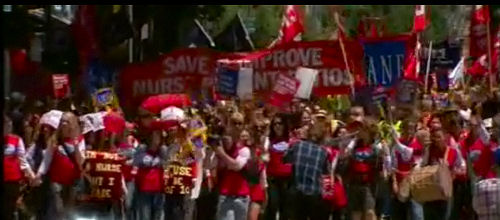
As news.com.au reported on 19 November, nurses who defy the orders of "Fair Work Australia" to end industrial action in support of their claims for some compensation for huge recent increases in costs of living and civilised working conditions, risk 12 months' jail -- this, in a country, which had the world's first Labor government ever and ratified the United Nations' International Labour Organisation's "Right to Organise and Collective Bargaining Convention" in 1973.
In fact, only 3 years after Labor Prime Minister Gough Whitlam signed the Convention, his successor, Malcolm Fraser, enacted the vicious sections 45D and 45E of the Trades Practices Act, which outlawed "secondary boycotts". Since then Liberal Governments, in collusion with subsequent "Labor" Governments, have taken away ever more of our collective bargaining rights.
http://candobetter.net
A website for reform in democracy, environment, population, land use planning and energy policy
 By upwards engineering population growth, the Victorian and Australian Governments are showing disregard of "ultimate deprivation" and leaving "future generations with the task of rationing energy, oil and food..."
By upwards engineering population growth, the Victorian and Australian Governments are showing disregard of "ultimate deprivation" and leaving "future generations with the task of rationing energy, oil and food..."


Today, Friday, 18thth November, 2011, Sustainable Population Australia, Victorian Branch president, Jill Quirk has condemned Victorian Planning Minister Matthew Guy's recently announced approval of a development at Clyde North of up to 6600 houses covering more than 400 hectares to expand the population by 18,500.
The previous Victorian Government's ‘Victoria in the Future’ (VIF) projections estimated that Casey could reach a population of 370,000 by 2026 which is larger than the present city of Canberra.
“Due to government growth policies, we are risking future food security by destroying prime agricultural land for new housing estates. As one of Australia’s most fertile and valuable agriculture areas, Casey should be preserved for the vital role of food production. Casey has a favorable climate, topography, fertile soils, supportive transport and recycled water infrastructure. With climate change, limited arable soil and oil depletion, Australia needs markets close to cities as Casey is to Melbourne.” said Ms. Quirk
“The push for ever more population growth by governments and business is denying us the chance of an environmentally sustainable future. The apparent lack of real long term thinking with regard to population and the emphasis on the electoral cycle from our politicians will leave future generations with the task of rationing energy, oil and food, and untangling the transport gridlock. The Victorian government should now concentrate on providing reliable transport services to the existing outer suburbs rather than seeking to swell these areas with anther million people by 2025.”
“Instead of planning and policies based on growth and the disregard of ultimate deprivations, we need policies based on realistic appraisals of our long term needs, a sustainable population, and sustainable economy” said Ms Quirk.
Further comment: ph. Jill Quirk, President Sustainable Population Australia (Victorian branch) 0409742927.
(The patrons of Sustainable Population Australia are Patrons: Hon Bob Carr, Dr Paul Collins, Prof Tim Flannery, Prof Ian Lowe, Dr Mary E White.)
 It has been more than two years since Environment East Gippsland began legal action to sue the government’s logging monopoly, VicForests. In August 2009 we applied for an injunction for an immediate stop to logging at Brown Mountain. A year later, on 11 August 2010, the ruling was handed down. We had won our case! This is a report from Environment East Gippsland.
It has been more than two years since Environment East Gippsland began legal action to sue the government’s logging monopoly, VicForests. In August 2009 we applied for an injunction for an immediate stop to logging at Brown Mountain. A year later, on 11 August 2010, the ruling was handed down. We had won our case! This is a report from Environment East Gippsland.

Not only did Environment East Gippsland win the case for Brown Mountain, but we successfully set three major precedents for other community groups:
1. it was the first time any environment group had been granted standing[1] to take the government (or one of its agencies) to court,
2. we were granted an injunction against logging for the first time in Victoria and possibly Australia, and
3. We did not have to provide ‘security’ a type of ‘bond’ incase we lost (VicForests put in what turned out to be a fairly bodgie claim that we should put up $60,000).
The case was set down to be heard in the Sale Court over two weeks, but it stretched out to four weeks through March 2010. Although we were successful, and although the ruling should alter the way VicForests and the government looks after public forests, we are still seeing them disregard the same laws and regulations over which they were sued. Their reasoning? The ruling technically only applied to Brown Mountain. So if we want to show that the law applies across the state, it might take another court case! They are gambling that we won’t resort to this. But to ensure that any further plans to challenge them are stymied, VicForests is refusing to pay our court costs as ordered. EEG and our lawyers have sent reasonable requests for the money owed. After months of letters, VicForests offered us HALF of our costs! This insult means that the case will now be handed over to official auditors to draw up the bill of costs and if not paid, it heads back to the court. More costs and more time wasting.
Brown Mountain’s 600 year old trees are still firmly in the ground but remain like a ‘hole in a donut’, surrounded by reserved forest and National Park. Despite its values having been well and truly proven in court, it is still mapped as a logging zone and under the control of VicForests. The surveys ordered by the court have not been carried out. We suspect they see this area as symbolic of the battle between ‘government and greenies’. We saw the length and cost the DSE went to in order to gut the heart from Goolengook’s forests. Let’s hope they are simply cooling their heels rather than plotting its annihilation. Being legally trounced by EEG must have hurt. We know that the 1995 Forest Management Plan is considered redundant and in need of rewriting, and we know there are plans of weakening the Flora and Fauna Guarantee Act; both documents helped our court win.
One outcome of the court case is that VicForests have set up very poorly funded Mickey Mouse pre-logging surveys in some forests. Consultants are hired that employ others to carry out wildlife surveys for some species. The consultants are given minimal time and resources, making the results totally invalid. We are currently applying under Freedom of Information to obtain details of these survey methods and results.
VicForests hired Chela Powell, a young forester with a PhD on the study of beetles in blue gum plantations. They call her their ‘conservation biologist’. She devised some survey methods that seem to us to explain how to look for certain animals in the wrong forests and then frighten them away with the wrong methods. VicForests also decides which forests might be deemed worthy of a survey. It is they who decide if a stand of forest is old growth, and it is they who give themselves the option of including forests that might be considered to be High Conservation Value (HCV). We have reason to suspect that they are doing pre-logging surveys in about half of the old growth they should, and almost no HCV, as this one is optional. There are some low quality forests surveyed that will most likely result in no finds. We also know they have logged old growth forest since the court ruling and are also clearfelling Potoroo habitat where their own contracted survey teams discovered them!
The legal finding for Brown Mountain should mean that logging agencies and land managers have to be cautious in regards to the possible existence of threatened species where they plan to destroy or alter their habitat. This can be extrapolated to every other forest, meaning cautionary management must be shown (as in the Precautionary Principle, much debated to in court) when planning to destroy or modify likely habitats of threatened species. This could include areas in which the DSE plans to carry out roading or prescribed burns, as well as clearfell logging. DSE is stating this isn’t the case, but provides no explanation. Surveys should happen across all forests – regardless of their age or conservation value. But it’s not.
VicForests have a few options:
· Honour this ruling and pay for decent, credible surveys in every planned logging coupe. Don’t log where rare species exist.
· Honour this ruling but do the cheapest possible ineffective surveys that cover minimal forest areas.
· Accept that the logging industry and its shrinking markets are in terminal decline and wind down operations to suit.
· Influence the revision of the Forest Management Plan to remove prescriptions to protect rare wildlife.
· Push to have the Flora and Fauna Guarantee Act watered down to make current mandatory actions ambiguous or ‘flexible’.
Greg Barber, MP for the Greens, asked a question of the then ALP Environment Minister the day after the September judgement. Minister Jennings said he would honour the decision. The Shadow Minister for the environment, Liberal member Mary Wooldridge, also promised to honour the court ruling. Now that a Liberal-National party is in Government, we see a clear attempt to take no action while planning changes of environmental legislation.
---
It was August11 and everyone stood as Justice Robert Osborne entered and took his seat. Throughout the March case, he always seemed to have a quizzical, bemused look on his face as he bowed to us on entering and leaving. Again he bowed and so did we. We had been anxiously waiting months for this moment. He began to read his findings. The court room booked for the judgement had to be changed to accommodate the one or two hundred supporters. When Liz and I walked into the upstairs gallery there was a sea of friendly faces and standing room only. In one corner was a very small huddle of grey suits representing VicForests.
Our hearts sank to the floor as he acknowledged some points which VicForests had made, and our points on the crayfish and kite that weren’t strong. But then he uttered the word “Nevertheless ...” and our hearts jumped back into place as we anticipated his next words. Basically he told VicForests that they can’t log the old growth forests of Brown Mountain until VicForests had:
1) put in place protection zones for the Potoroo in three of the four planned logging coupes,
2) had qualified people survey in the correct season for Giant Burrowing and Large Brown Tree Frogs as well as the Spot-tailed Quoll, in all four coupes,
3) created a 100 ha zone to protect the gliders of coupe 15 and,
4) reviewed the protection measures offered to Powerful and Sooty Owls in East Gippsland.
But he didn’t go far enough to say they must do this to the satisfaction of the court, only to the satisfaction of the Director of Biodiversity Policy and Programs within DSE. That was the weak point.
He also ordered that we:
· give DSE copies of all photographic evidence we have of the presence of the Long-footed Potoroo in the area (our lawyers told us not to provide this once the case had started); and
· show DSE the precise location of where one of the Potoroo images was captured as used in our evidence by one of the surveyors.
Our lawyers argued that a ‘compliance in an unsupervised fashion’ and a ‘self-executing injunction is not appropriate’ given VicForests’ past record of strong resistance to compliance and an ‘ineffective regulator’ (DSE). They said that the history of this matter showed that there was no transparency or honest dialogue from DSE/VicForests towards EEG.
However the judge claimed it shouldn’t need to go back to court for tick-off when there’s already a DSE statutory framework in place to resolve habitat protection (which we just proved wasn’t working). As DSE wasn’t part of the dispute, he considered them as apart from it. But we showed they were as good as compliant with VicForests’ refusal to properly protect the wildlife. Still, if given the legally correct reserves, these logging coupes should all receive protection, even if vulnerable to being moved and swapped as Special Protection Zones.
To ensure proper transparency, Justice Osborn ruled that VicForests should give EEG:
· relatively detailed maps of the protection zones for the Potoroos and owls within 14 days of their creation.
· details of any survey results of the Giant Burrowing Frog, Large Brown Tree Frog and Spot-tailed Quoll.
· 28 days notice in writing of plans to log any of the four coupes.
We have received nothing to date.
[1] Editor: "Standing" is the legal right to initiate a law suit. Yes, if you thought that anyone could initiate (via a lawyer) or as themselves, a complaint of a failure to abide by regulations or laws in an Act, think again. Usually this right is very much reserved, with the effect of protecting vested interests and specialists. Not only did EEG set a precedent in getting standing, but I think they set a precedent in using the Flora and Fauna Guarantee Act 1986 in court! I believe that no action had previously ever been made using its powers!
 Proposed revisions to the Code of Practice for Forestry in Victoria Australia could adversely impact Victoria's threatened species. As many candobetter.net readers know, the Victorian Auditor General found last year that Victoria has utterly failed in its objectives under the Flora and Fauna Guarantee Act (1986) to measure and protect unique species from threat and endangerment. These changes also follow Environment East Gippsland's historic win in court against VicForests last year, where EEG sought protection under this Act for endangered species. With these changes, loggers could seek exemptions from state environment laws protecting endangered species. Victorians (and people all over the world) need to be aware of these proposed changes and to make comments. You can make a submission via this article
Proposed revisions to the Code of Practice for Forestry in Victoria Australia could adversely impact Victoria's threatened species. As many candobetter.net readers know, the Victorian Auditor General found last year that Victoria has utterly failed in its objectives under the Flora and Fauna Guarantee Act (1986) to measure and protect unique species from threat and endangerment. These changes also follow Environment East Gippsland's historic win in court against VicForests last year, where EEG sought protection under this Act for endangered species. With these changes, loggers could seek exemptions from state environment laws protecting endangered species. Victorians (and people all over the world) need to be aware of these proposed changes and to make comments. You can make a submission via this article
According to comments reported in the Age, 3 November 2011:
The Secretary of the Department of Sustainability and Environment would be able to exempt a logging project from the requirements of the Flora and Fauna Guarantee Act, which protects the state's endangered and threatened species.
"The proposed changes follow a landmark ruling in the Supreme Court last year banning VicForests from logging old-growth forest at Brown Mountain in East Gippsland, after an endangered long-footed potoroo was filmed in an area to be felled."
"The secretary will consider, among other things, the numbers required to maintain a viable population of a listed species in the area to be logged, and the amount of habitat near the proposed coupe already protected in national parks."
''The objective of the variations is to achieve a better balance between the protection of threatened species and sustainable timber production from public native forests.'' Source: Tom Arup, "New state law in the pipeline to aid loggers."
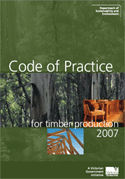
The Code of Practice for Timber Production 2007 (the Code) is a key regulatory instrument that applies to commercial timber production in both public and private native forests and plantations in Victoria. It is a statutory document prepared under Part 5 of the Conservation, Forests and Lands Act 1987. Compliance is required under the Sustainable Forest (Timber) Act 2004 and via its incorporation into the Victoria Planning Provisions.
The purpose of the Code is to ensure that commercial timber growing and timber harvesting operations are carried out on both public land and private land in such a way that:
Code of Practice for Timber Production 2007
![]()
[PDF File - 2.1 MB]
Members of the public are invited to provide comment on a number of proposed variations to the Code of Practice for timber production to improve certainty of timber supply to the native forest timber industry, while balancing the needs of the environment.
Document explaining the proposed variations
The following document outlines the proposed variations to the Code of Practice for timber production.
Proposed variation to the Code of Practice for Timber Production 2007
![]()
[PDF File - 162.3 KB]
Proposed variation to the Code of Practice for Timber Production 2007
![]()
[MS Word Document - 60.0 KB]
If you have problems downloading this document, please contact the Customer Service Centre on 136 186 for assistance.
Summary
The proposed variations change the wording in relation to the application of Flora and Fauna Guarantee Action Statements. This aims to introduce more flexibility and allow further consideration of the importance of Victoria’s national parks and conservation reserves in the protection of threatened species.
The variations will improve the focus of conservation for threatened flora and fauna species to be applied at landscape level, and allow for a reduced focus at the individual animal or plant level.
Factors needing to be considered by the Secretary to the Department of Sustainability and Environment in determining the application of a Flora and Fauna Guarantee Action Statement are also being considered for inclusion in the Code.
Submission of comments
Anyone interested in making a submission on the proposed variations should provide their comments to DSE in writing by:
Mail:
Review of the Code of Practice for Timber Production
Forests and Parks Division
Department of Sustainability and Environment
PO Box 500
East Melbourne, VIC, 3002
Email:
[email protected]
Closing date: submissions must be provided by Wednesday 1 February 2012. Submissions received after this time may not be able to be considered.
The department ensures that all timber harvesting operations are undertaken in compliance with relevant legislation and with the Code of Practice. Find out more about timber harvesting compliance.
Related Links
The Code refers to various laws and policies that may be subject to change. Links to state policies and other information relevant to the Code are provided below.
 Victoria's Mornington Peninsula Shire wants to build the largest building project they have ever undertaken on foreshore public reserve land at Rosebud. The proposed complex would be 50 times larger than a recently condemned pool and needs parking for 200 vehicles. Why change something as perfect as Rosebud? Is the council mad?
Victoria's Mornington Peninsula Shire wants to build the largest building project they have ever undertaken on foreshore public reserve land at Rosebud. The proposed complex would be 50 times larger than a recently condemned pool and needs parking for 200 vehicles. Why change something as perfect as Rosebud? Is the council mad?

Marine crocodiles and box jellyfish made it too dangerous to swim on Cairns foreshore in Northern Australia, so the construction of a public 4 hectare built lagoon made some sense. Why, however, would you try to build something like this on the Rosebud foreshore? Rosebud foreshore is like a giant, safe lagoon already.
In fact, the coastline around Port Philip Bay, Australia, is so scenic, safe, and accessible that most normal people in the world would look at it and think that it was perfect - but not some of the people in the local council.
Dr Alan Nelsen, Secretary, of Mornington Peninsula Ratepayers’ and Residents’ Association, Inc.[2] expresses local concern and amazement at this strangely inappropriate project.
"All Victorians should be pleased with the rejection by the government’s Department of Sustainability and Environment’s refusal to sell Port Phillip Bay foreshore public land for an illegally built private pool in Mt Eliza. The Mornington Peninsula Shire Council applauded the decision. [1]
However, what is of greater concern to all Victorians is that the executive of the very same council and a local councillor are lobbying the government to construct its own aquatic/leisure complex, “the largest building project undertaken by the Mornington Peninsula (shire)” on the same bay foreshore which is public reserve land at Rosebud. The proposed complex is 50 times larger than the condemned pool and requires a car park for 200 vehicles.
Hypocrisy or incompetence? The shire also refuses to recognise that its low-lying site is likely to become one of the worst affected by inundation from sea level rise on the bay foreshore. Perhaps users will be able to swim out to the complex.
A further embarrassment is that the proposal to use public open space is inconsistent with the recent comment by the government’s Minister for Planning who said he would be making new parks for Melbourne.
The bay foreshore belongs to all Victorians and must not be allowed to be squandered by a shire executive and local councillor to build a monument to themselves, dubbed by many as “Palace de Versailles by the sea”."
[1] The Sunday Age, October 9, 2011.
[2] Dr Alan Nelsen, Secretary, of Mornington Peninsula Ratepayers’ and Residents’ Association, Inc.
PO Box 4087, Rosebud Vic
Email: alanne[AT]ihug.com.au
 Victorian government plans to drop 1080 poison bait from an aircraft into forests could result in the extinction of the already critically endangered Spot-tailed quoll. The purpose of this antiquated and vandalistic method is to poison wild dogs.
Victorian government plans to drop 1080 poison bait from an aircraft into forests could result in the extinction of the already critically endangered Spot-tailed quoll. The purpose of this antiquated and vandalistic method is to poison wild dogs.
Article by Hans Brunner, Wildlife ecologist and biologist

The Victorian government plans to drop 1080 poison bait from an aircraft into forests which could result in the extinction of the already critically endangered Spot-tail quoll. The purpose of this hazardous, antiquated and vandalistic method is to poison wild dogs. This is like re-introducing the use of DDT. It is now a double disaster: all Ted Baillieu has to do now is to aerial bait to kill wild dogs in order to protect the cattle he allowed to go back into the mountains.! An estimated success rate for aerial poisoning of wild dogs is one tonne of poison bait per one dog! Spot-tailed quolls and other Dasyurids are meat eaters as well as some species of possums, reptiles, bandicoots, bush rats and birds. It was estimated that 90% of baits were either not eaten or taken by other animals. Raptor and scavenger birds may collect poison bait and take them to feed their young. McIlroy (CSIRO) reported that in one campaign birds took over 40% of the bait. These other animals would all be at serious risk of being poisoned. Further more, most of this bait would be wasted because of the dogs not being able to find them and this is where non-target animals will rather find and eat them. Baits have therefore to be placed only in places which dogs frequently use, along forest tracks.
There is a well researched and efficient method for the poisoning of wild dogs and foxes. It is a target specific bait station system which is successfully used throughout Victoria. Bait stations are placed along forest tracks where activities of dogs are observed.
A bait station consists of a mound of soil about 20 cm high and one meter in diameter. An un poisoned bait (free feed) is buried in the center of the mound about 10cm deep with some SFE lure placed on top. When the bait has been dug up and eaten, a check is made, with some experience, to assess whether a dog or fox took the bait. If satisfied that a target species took the bait it can be replaced with a poison bait. If it appears that a quoll or an other non-target animal may have taken the free feed bait, continue free feeding that station to keep the quoll and others away from a poison station (about 2 km away) or eliminate that station.
This is the only responsible way to poison dogs and foxes. Even better, it will be of great benefit to not only the quolls by removing the competition by dogs and foxes of their natural prey species, but also for the survival of Kangaroos, wallabies, bandicoots, possums, echidnas etc.
I have researched and tested this system in 700 square km of forest between Gembrook and Neerim and found it most effective and efficient. I have also introduced it in NSW National Parks where it was recognized as “The dog baiting stations proposed by Hans are the best practical suggestion to date. With the implementation of the bait stations, properly maintained and serviced at the appropriate times, there would appear to be NO reason to allow the continued use of aerial baiting” and, “Poisoning using the buried bait technique is still proving extremely target specific, with dogs and foxes being the only species killed”.
Barbara Triggs, an eminent naturalist stated after poisoning wild dogs and foxes and using the bait station system on her property in Croajingolong Nat. Park:
“At no time has there been any evidence that a bait has been taken by a non-target animal. In the past year the numbers of native animals seen on the property have increased startlingly. The Red-necked Wallabies, who’s group was here in low numbers, have increased markedly from five individuals to now at least fourteen. The most surprising increase has been in the population of Long-nosed Bandicoots. The Dusky Antechinus, Swamp Rats, Water Rats, Sugar Gliders and several species of ground-nesting birds and also species of owls are much more in evidence than ever before."
With all this evidence, this non specific and irresponsible aerial baiting must be immediately stopped.
Hans Brunner
Wildlife biologist
Sept 2011

No Surprise: The Department of Sustainability and municipal councils' positions on recycling have long been an insult to the intelligence of the population. The auditor general's report should also be used to expose "Green" groups that collude with government on this nonsense and to muzzle sustainable population voices. The audit found that the Department of Sustainability and Environment, Sustainability Victoria, the Environment Protection Authority, the Metropolitan Waste Management Group, one regional waste management group and four municipal councils have not effectively fulfilled their roles in implementing the strategy, resulting in ineffective planning, leadership, coordination, and oversight. And gee, we are not going to meet our so-called target of Towards Zero Waste Strategy by 2014.

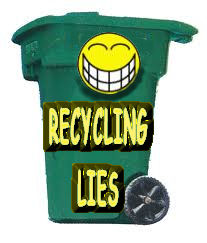
The audit found that the Department of Sustainability and Environment, Sustainability Victoria, the Environment Protection Authority, the Metropolitan Waste Management Group, one regional waste management group and four municipal councils have not effectively fulfilled their roles in implementing the strategy, resulting in ineffective planning, leadership, coordination, and oversight. No surprise that the so-called target of Towards Zero Waste Strategy outcomes being achieved by 2014 in relation to municipal solid waste won't be met. It is particularly shameful is that the Government and colluding Greenish groups have consistently tried to drown out concern about overpopulation by marketing recycling as if it were much more effective than it could possibly be. The questionnaires for the annual event of the Sustainable Living Festival have consistently required environmental groups to rabbit on about what they manufacture and the recycling they do, which places nature preservation and overpopulation groups at a false disadvantage since most are not in business or manufacturing and have little or no built space.
This audit examined whether waste management and resource recovery actions have been effective and efficient in achieving the Towards Zero Waste Strategy objectives and targets for municipal solid waste. It reviewed the activities of the Department of Sustainability and Environment, Sustainability Victoria, the Environment Protection Authority, the Metropolitan Waste Management Group, one regional waste management group and four municipal councils.
The audit found that Sustainability Victoria and the Department of Sustainability and Environment have not effectively fulfilled their roles in implementing the strategy, resulting in ineffective planning, leadership, coordination, and oversight.
Sustainability Victoria has missed an opportunity to review and modify the strategy to improve its effectiveness. It also missed an opportunity to review its own practices. This has diminished the prospect of the Towards Zero Waste Strategy outcomes being achieved by 2014 in relation to municipal solid waste.
Link to audit summary and full report:
http://www.audit.vic.gov.au/reports_and_publications/latest_reports/2010-11/20110629_municipal_waste.aspx">
In his Short Report (Tabled in Parliament: 29 June 2011) the Auditor General states:
"The 2005 Sustainability in Action: Towards Zero Waste Strategy (TZW) set statewide objectives and targets to reduce the amount of solid waste generated and increase recovery rates for individual waste streams—thereby decreasing waste disposal to landfills. It also set out to reduce litter.
Sustainability Victoria and the Department of Sustainability and Environment have not effectively fulfilled their roles in implementing the strategy, resulting in ineffective planning, leadership, coordination, and oversight.
While Victoria met four out of six mid-term TZW targets, progress related to the municipal solid waste sector, a significant source of organic waste, and therefore greenhouse gasses, has been slow. Waste generation continues to rise above expectations and little improvement in reducing this rate of increase is envisaged over the remainder of the strategy's life.
Sustainability Victoria has missed an opportunity to thoroughly review the strategy and modify it to improve its effectiveness. It has also missed an opportunity to review its own practices in light of its lead role and the existing level of underperformance. This has diminished the prospect of TZW outcomes being achieved by 2014 in relation to municipal solid waste."
The Department of Sustainability and municipal councils' positions on recycling have long been an insult to the intelligence of the population. The only surprise is that some relatively intelligent people have actually bought the spin. A year or two ago I was amazed to hear a man in charge of a big bit of a large hospital talk about how "We" were all getting on top of environmental problems by recycling. Childlike, he gave an example of how a surgical department had produced a plastic chair from recycled plastic products. Apparently it was being displayed as an example of progress on the problem of pollution and drawdown on resources - as if this were merely something that could be fixed by engineering.
People need to realise that disposable goods and the scale of manufacturing and consumption is laughably unsustainable. It is a sick joke.
About the only useful recycling possible for most of us to practice regularly is that applied on a small scale at home in composting.
No attention is given to the amount of fuel used and pollution generated by recycling inorganic and highly processed materials (such as plastic) on a large scale. No attention is given to the childish math problem of how you cannot meaningfully reduce energy and pollution when you are increasing production and consumption. When recycling is done 'for profit' the problem is even more ridiculous. You can bet that the community, the tax payer, is underwriting scams that use trucks and factories and all sorts of fuels for transport and reprocessing of manufactured bits and pieces. For instance the late Richard Pratt, who was often trotted out as some kind of hero by the growth-extremist Victorian Government under Bracks, had a major business, subsidised by the public, getting stuff from councils and sending it on boats to Taiwan for reprocessing. How anyone could have been fooled by the recycling paradigm in gross or in detail is hard to imagine. Unfortunately the story of the Emperor's New Clothes effectively portrays the unsophisticated state of the nation - and of most peak environment groups (including the ACF, which for a long time effectively promoted Dick Pratt as some kind of business-man eco-hero on this issue) the Greens and the Friends of the Earth. The most shameful thing about this unrealistic and misleading position is how the same groups have used and abused it to deter Australians from acting quickly to stop overpopulation. Again and again they have effectively frightened people from speaking out on high immigration, yet have offered nothing in aggregate of any net effectiveness to help us all avoid catastrophy.
Glass recycling can be very effective, but the use of returnable bottles has been almost entirely phased out. The reason is false profit at the expense of the community because more money is to be made by manufacturers in churning out petroleum-based disposable containers of extremely overpriced lollywater, diabetagenic fruits and juices and fatty sugary milks. In some cases some plastics are inconveniently and fuel and pollution expensively somewhat recyclable. They don't compare to glass. Overwhelmingly the main feature of glass containers is their durability. Broken glass for reforming is already a stage down in recycling value because it becomes a factory project which needs larger scales, so lots of fuel, transport etc.
Metal recycling can be very effective, as in building and construction materials.
Wood recycling in building can also be extremely effective, where we are reusing whole materials to rebuild. That is doors, lintels, roof-pieces, glass. The idea is to carefully take a building apart and use the materials again. This should happen without transporting those materials over great distances, using fossil fuels.
Manufactured goods recycling:
Tools should also be available for people to borrow or hire cheaply from local governments, instead of so many households having their own fossil-fuel expensive drills, sanders etc.
The fact that no state or federal government seriously supports any of the above effective recycling, yet all of them abuse the notion of recycling for profit, is a condemnation of our leaders.
James Sinnamon, the owner and creator of this internet site, candobetter.net, has long proposed that building materials and tools be held in depots by local governments for reuse by anyone who needs them. Unfortunately a serious accident from which he is still recovering has made it impossible for him to push these projects as effectively as he would wish or to persevere in running for political office on them in the foreseeable future.
Bio-gases
Small-scale local production of cooking gases from compost is also effective, but probably not when communities try to make a profit on selling the gas because the economies of small-scale disappear and transport requires subsidies.
Sewage waste recycling
Sewage waste can be effectively recycled or more properly made into clean water and soil components by allowing it to be processed on a managable scale through natural systems. This is already done by a lot of sewerage systems which are state subsidised or managed.
Medical Instruments waste
Compare the massive use of plastic disposable needles and syringes with the earlier practice of metal and glass syringes and needles which were actually disinfected and reused time and again by hospitals. Similarly, instead of disposable plastic packs, reusable towels and metal instruments were used for small-scale operations and large ones. It required more permanent and responsible staff, more local water and fuel (but less globally) and more time, plus generally more careful and thoughtful practice. The style runs counter to the flashy and wasteful use of resources and human resources for rapid and spurious efficiency of modern hospital practice.
There were reports from residents of shooting last night (Friday, as reported by Fiona Corke) and as kangaroos are very stress prone, there are reports of them fleeing in fright, and they could abandon joeys and get caught in fences. Injuries could result. This violence is horrifying. The DSE should be responsible in caring for wildlife, not the contrary!
EXCLUSIVE: Shots heard as Eden Park kangaroo cull begins
The Department of Sustainability and Environment late last year approved NMIT’s application to kill 300 kangaroos until October. and for the next three years.
According to the police, That is a matter between police and the permit holder. This is hardly true! The kangaroos are our iconic native animals and belong to everyone. The Council unanimously agreed to support them, and so do many residents. There are no valid reasons to kill them.
The DSE have employed shooters were in the Whittlesea area shooting kangaroos and causing mayhem and distress. Why is the State government department above the laws that protect native animals?
"Overgrazing" is not a reason, even in the Wildlife Act (vic) to kill them. They are taking the law into their own hands and ignoring the public, the council and the residents in the area. How can public violence and crime be stopped if we have a State department - the DSE - gone feral?
There is no reason to kill the kangaroos and DSE are not giving any clear answers. Why aren't they dealing with the feral rabbits?
There is something very strange going on, and the DSE's 19th century attitudes are totally out of touch with community attitudes and values. Why do land-holders get so much veneration? We live in the 21 century now, and wildlife belongs to us all. Too much land in Victoria is in private hands.
Kangaroos are not a pest and very rarely will eat crops, only in extreme drought. The grass is almost knee high!
Not only do we have a duck shooting season this year, for the full 3 months, but with 10 birds per day per shooter it is likely to be the biggest massacre of native waterbirds for many years.
Campaign Director, Laurie Levy, said: Waterbirds have only just begun to recover in response to the rain in Victoria and east coast Australia. However, five years of heavy, replenishing rain must fall to allow bird numbers to build up.
Levy maintains that allowing 20,000 duck shooters to each bag up to 10 birds per day for three months could result in over 15 million shot, when there are still only a few thousand birds in Victoria.
Please could everyone send a complaint through to the RSPCA to [email protected] (a plea from Fiona).
We have urban sprawl threatening our native grasslands and biodiversity, cattle permitted in the Alpine National park, besides the evidence contrary to fire prevention, a record duck shooting season with more permitted to be killed than numbers of birds, and kangaroos under attack for no apparent reason!
Tim Baillieu, when elected as our new premier, promised a transparent and honest government without hidden agendas. He also promised a common-sense and stable approach to running this state. Where is the transparency and “common sense” with the brutal treatment of native animals being hounded and slaughtered in our suburbs and wetlands?

On Tuesday, 8 February 2011, Member for the Victorian Opposition, Martin Pakula (ALP) pointed to the effective cartel which a supermarket may form in its own right, in a bad situation for farmers which, to me is a danger signal that cows will suffer even more (although Mr Pakula did not mention the suffering of cows).

"Anyone who has been to Coles or Woolworths in the last few weeks would know of the decision by the retailers to slash the price of their home brand dairy products, and it seems more of this is on the way in regard to baked goods. This has been described in some circles as a win for consumers, but in the longer term I am not sure that will be the case," said Mr Pakula.

Like other people I have noticed that prices are rising in supermarkets. The prices for dairy rose markedly during the long period of drought which has only recently been broken by floods. At the same time, I noticed that supermarket brands were far cheaper than other brands of cheese and milk. It was very tempting to buy, for instance, Coles cheddar cheese, because it was several dollars cheaper than something like Crackerbarrel.
I wrestled with my conscience because I knew that the 'bottom line' in the case of dairy products was cows. The cheaper the cheese the worse for the cow. Cows are so badly treated that any worse treatment seems inconceivable, yet there seem no real limits to how badly commerce will treat the creatures it relies on for its bounty. Only government can legislate and enforce better standards for animals, but unfortunately they seem to do the opposite in this country because they focus on so-called efficiency over the meanest standard of decency. Only the other day we published an article on candobetter.net about how industry and government want to change laws to give permission to treat bobby calves so badly that they have a good chance of dying before they even get to market.
Prices for milk and agricultural product began to rise quickly as population began to grow in Australia and, in Victoria, as the Labor Government joined forces with corporate interests to take over farmland, using strategies like removing control of water from family farms and repackaging it at different prices according to opaque measurements of industry values. Corporate bidding pushed up land-prices and this eroded profit margins for farmers. If the price of land goes up, everything else does. Who pays - besides the farmer? Livestock do. Only the big corporate agricultural holdings can survive and then only in the short-term, but the corporates are only there for the short-term, to make a killing.
Prices continue to rise as widespread damages to agriculture surface with Australia's massive floods.
I know it can get even worse for cows because in the US they are sometimes milked as frequently as four times a day, causing their skeletons to break down[1] and they die or are killed around the age of four. Imagine the arthritic pain of constantly breaking bones.
In Australia cows often live to be eight. A very old cow may reach twelve. Some cows, however, have lived to be over 30. (Here is a lovely story about one in Australia who was saved by a livestock agent and resides with an abattoir owner.) Search and you will find the same for many other species. Such discrepancies in life-expectancy are an indication of how bad the effect of our industrial 'efficiencies' is for non-humans (and not so great for humans either.)
Below is Mr Paluka's statement, which describes a big problem in the centralisation of markets where individual farmers are disempowered by the more easily self-organising retailers.
On Tuesday, 8 February 2011, Member for the Victorian Opposition, Martin Pakula (ALP) pointed to the effective cartel which a supermarket may form in its own right, in a bad situation for farmers which, to me is a danger signal that cows will suffer even more (although Mr Pakula did not mention the suffering of cows).
"Anyone who has been to Coles or Woolworths in the last few weeks would know of the decision by the retailers to slash the price of their home brand dairy products, and it seems more of this is on the way in regard to baked goods. This has been described in some circles as a win for consumers, but in the longer term I am not sure that will be the case.
The retailers have enormous market power, far more than the multinationals that Coles CEO Ian McLeod talks about, and they use it ruthlessly. Many of the manufacturers who supply branded products — like Pauls, Pura, Devondale, Western Star and the like — also supply Coles and Woolies home brand products.
So the retailers saying they will not cut the price paid to suppliers for branded products is hardly the point. As supply contracts expire, the substitution to home brand products will inevitably impact on the price paid to manufacturers, the security of hundreds of Victorian jobs and the viability of primary producers as well. If the dairy suppliers got together and agreed not to sell to the retailers at a price below X, they would almost certainly be prosecuted by the Australian Competition and Consumer Commission for collusion and would more than likely be convicted. But the behaviour of the retailers looks a little bit like predatory pricing, and perhaps it is time the ACCC took a look at that as well."
Martin Pakula (ALP) was appointed Minister for Industry and Trade and Industrial Relations in 2008. In January 2010, he became Minister for Public Transport. He is currently in the opposition.
MEMBERS STATEMENTS, Legislative Council, Victoria,
Tuesday, 8 February 2011, Hansardp.93, http://www.parliament.vic.gov.au/images/stories/daily-hansard/Council_2011/Council_Dec_2010-Jun_2011_Weekly_Book_2.pdf
[1] "Nutritional Disorders
Numerous diseases and conditions can occur within a cow’s skeletal system if the cow’s immune system is weak or if the cow is malnourished. Milk fever is one condition that affects cows when calcium leaves the bloodstream to support milk production faster than calcium is put back into the bloodstream through eating. The result is a muscular and skeletal breakdown, resulting in the cow being weak and unable to stand. Ketosis is another disorder that affects female cows in early lactation. By drawing body fat to help meet the energy needs of milk production, central nervous systems can become dysfunctional, causing cows to stumble, lose their appetite and become weak."

Melbourne's population is over 4 million
They are planning for 8 million
Is that too many?
How many is too many?
IS SUSTAINABILITY IMPORTANT ?
- Infrastructure, who pays for it ??
PUBLIC FORUM
Richmond Town Hall
333 Bridge Rd, RICHMOND
4pm, Sunday 7th November 2010
Speakers:
Andrew MacLeod, CEO Committee for Melbourne
Kelvin Thomson MP, Federal Member for Wills
Panel:
Melina Sehr - Stonnington City Councillor
Rupert Mann - Melbourne Heritage Action Group
David O’Brien - Planning Barrister
Mary Drost - Convenor Planning Backlash
Moderator - David Trenerry
Sponsor: PLANNING BACKLASH INC.
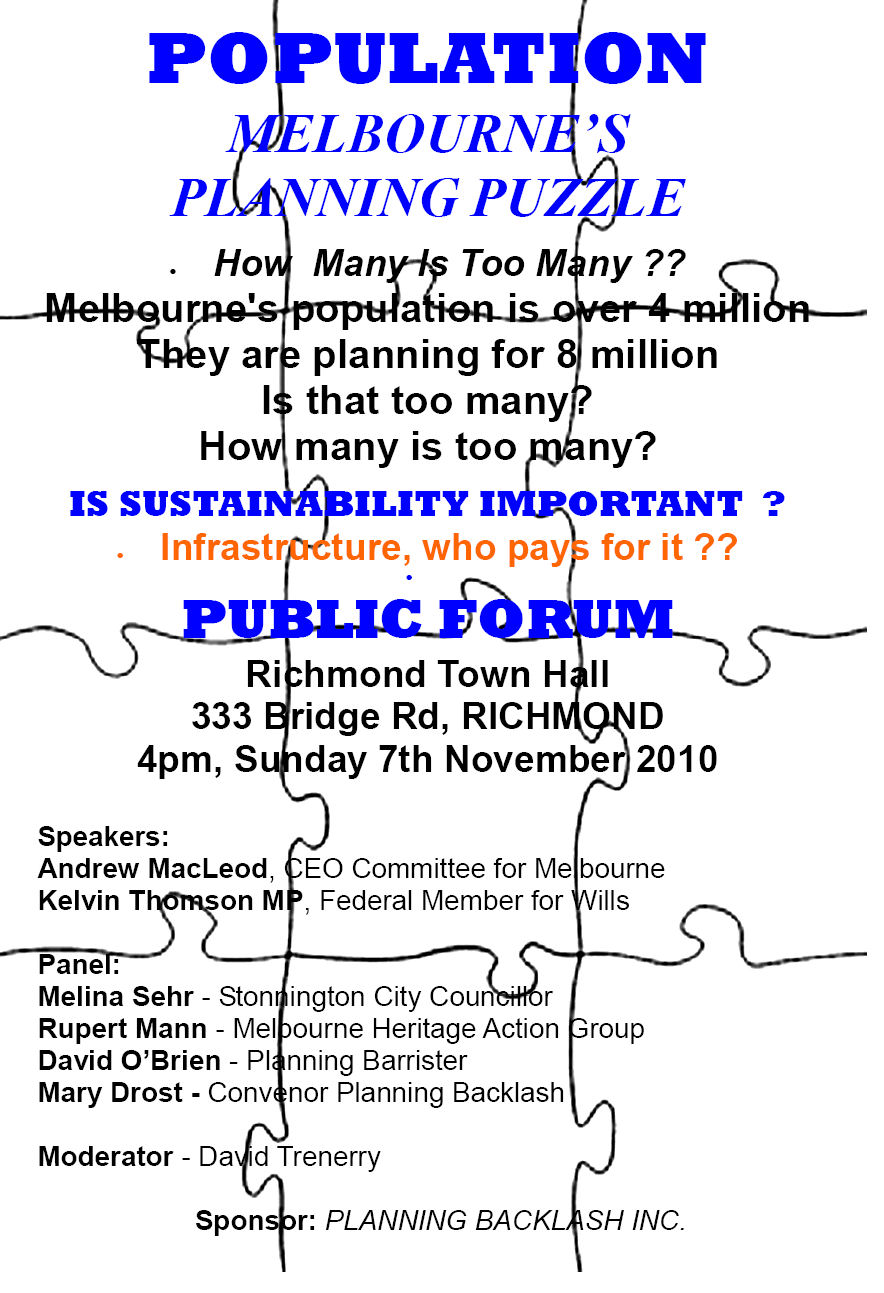
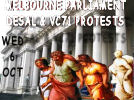 Midday: Anti Desal Plant Rally on steps of parliament, Melbourne. All supporters welcome. After that, go to the Upper House Gallery, Parliament House,and show your support to the Opposition's motion to Overturn Amendment VC71
Midday: Anti Desal Plant Rally on steps of parliament, Melbourne. All supporters welcome. After that, go to the Upper House Gallery, Parliament House,and show your support to the Opposition's motion to Overturn Amendment VC71
Watershed (formerly Your Water, Your Say) – those protesting the now infamous Desal Plant at Wonthaggi, ARE HOLDING A RALLY ON THE STEPS OF PARLIAMENT HOUSE, calling for the very expensive and deeply troubled project to be scrapped. You are enthusiastically invited to support them by being there – after all, its OUR money and OUR future too, not just theirs.
Wednesday 6 October (time to be advised but likely afternoon)
Matthew Guy, Shadow Planning, will be moving a motion in the Upper House to get rid of the terrible Amendment VC71 that was approved by Planning Minister Justin Madden last week. VC71 is a terrible amendment and terrible planning which puts Melbourne 2030 across all of Victoria, forcing metro standards on country areas, and makes it obligatory to have high rise and high density across the metro area (these provisions could also be applied in country areas).
Please show your support for getting rid of this horrid amendment by being at Parliament House Upper House gallery if you can. If you haven’t been to parliament before, here’s your chance to see how our democracy works (or not).
Also, please encourage Greg Barber (Greens) greg.barber[at]parliament.vic.gov.au and Peter Kavanagh (DLP) peter.kavanagh[at]parliament.vic.gov.au to support Matthew Guy’s motion by sending a message to both.
Source: Christine Pruneau of Macedon Ranges' Residents Association (MRRA)
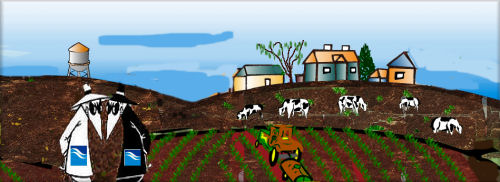
4th October 2010
Jan Beer, Plug The Pipe spokesperson and environmental activist in opposition to North-South Pipeline, is taking legal action against Government Agency Melbourne Water for alleged infringements of her right to privacy over a 2 year period.
Mrs Beer was photographed, video-taped and followed whilst the pipeline was being constructed. The Victorian Civil and Administrative Tribunal heard this morning that over 100 documents exist detailing the monitoring of Ms Beer by Melbourne Water.
“At no time during this period was I informed who the people collecting my information were employed by, why they were collection my information, and what it would be used for" says Mrs Beer.
“I felt harassed, persecuted and along with other opponents of the pipeline have been branded a “quasi-terrorist” by a Minister of the Victorian Government. In fact I feel as though I have been treated like a dangerous terrorist that needed to be silenced” said Mrs Beer “ It is like living under a dictatorship, rather than a democracy, where people have the right to peacefully protest.”
A Memorandum of Understanding is in place for the North-South Pipeline, similar to that for the Desalination Plant, between Melbourne Water and the Victorian Police. It is possible that the information collected on Ms Beer has been transferred to other parties pursuant to the MoU.
“The sheer volume of information collected on my client is astounding” said Elizabeth McKinnon, solicitor at the Environment Defenders Office. “At issue in the proceedings is whether Melbourne Water attempted to comply with the Information Privacy Act in relation to the management of protest activity at the site”.
The next hearing in this matter will take place in February 2011.
Recent comments